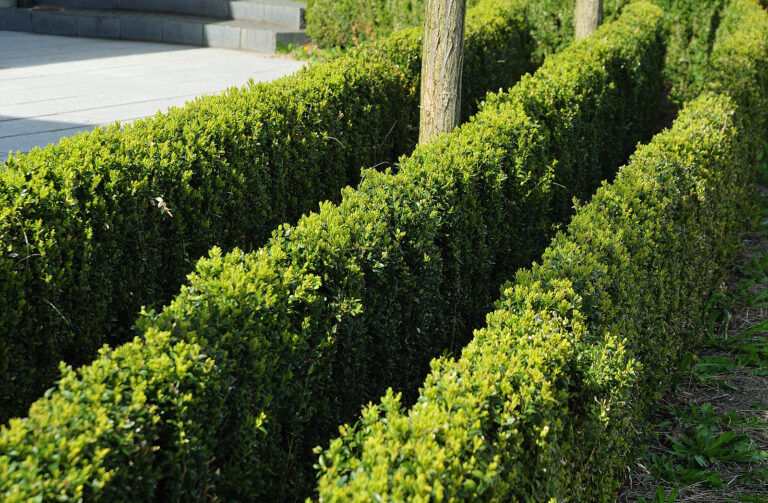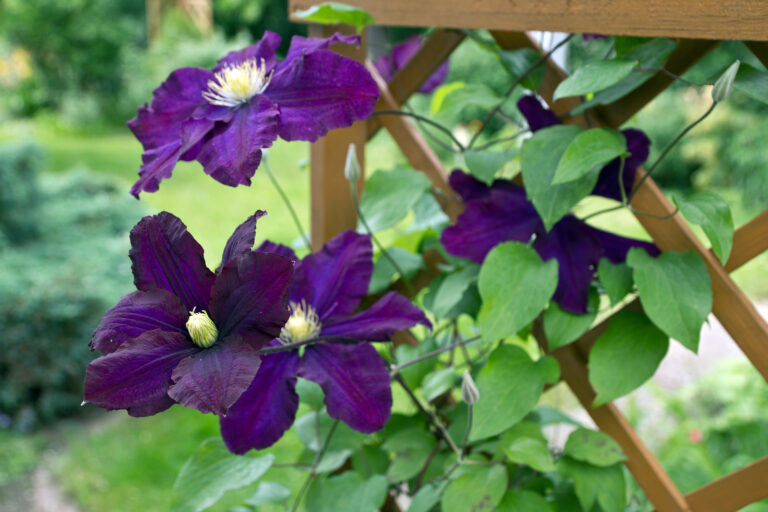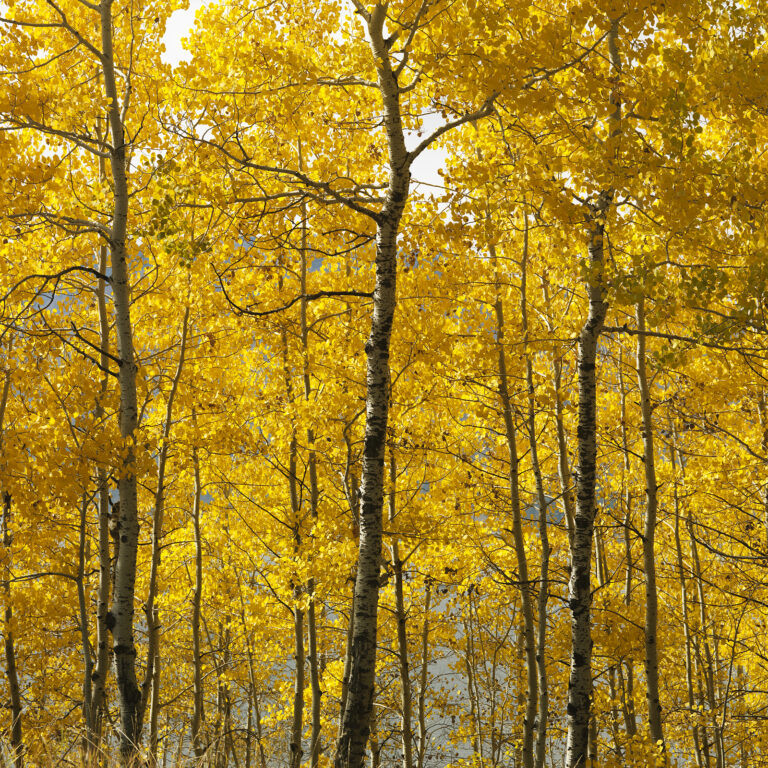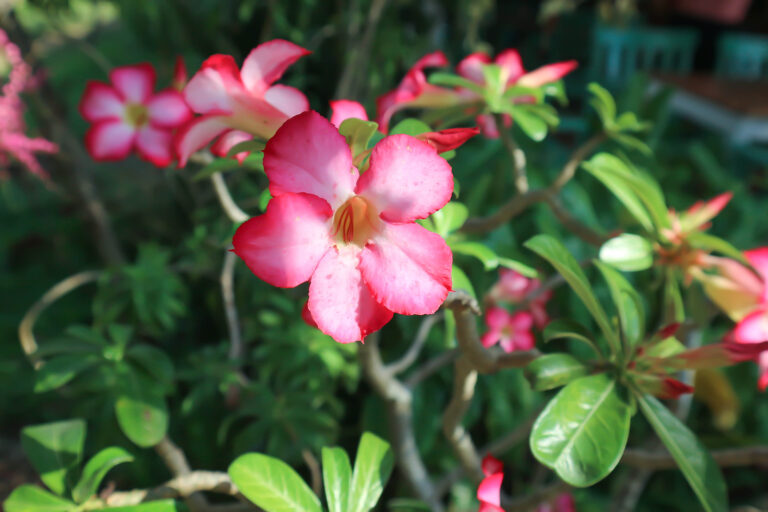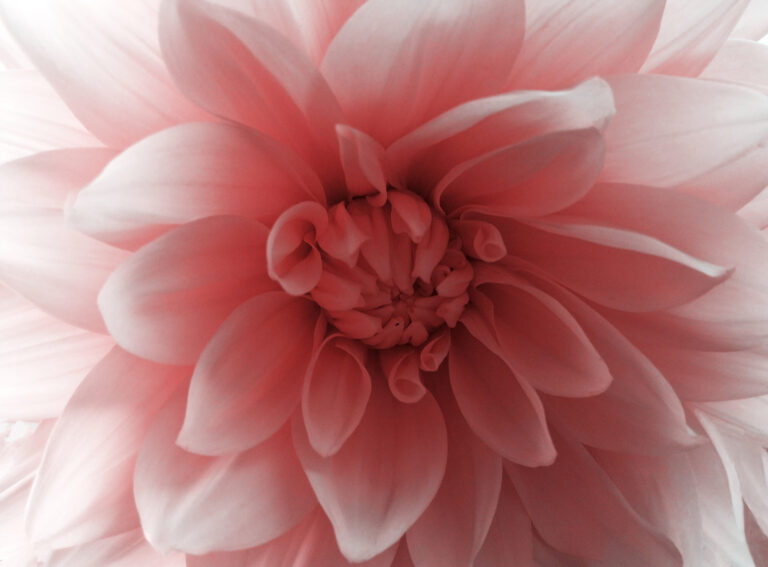45 Plants that Provide Food for Songbirds
Songbirds look to many annuals, perennials, shrubs, and trees as a natural source of food throughout the year. Nearly all plants that attract songbirds are equally attractive to humans for their colorful flowers, fruits, and leaves.
A steady supply of seeds, nuts, and berries will bring a variety of birds to your yard. Set aside annuals and perennials just to feed birds; let these plants flower and then set seed. The birds will soon arrive.
Many shrubs and trees bear berries and nuts that attract songbirds. Some shrubs and trees will bear fruit in summer soon after spring flowers fade. Others fruit in late summer and autumn and many berries and fruits remain on shrubs and trees into winter long after leaves have dropped. These plants not only feed birds but bring vibrant colors to the winter garden.
Here are 45 annuals, perennials, shrubs, trees, vines, and groundcovers that will attract songbirds to your garden.
Annuals
 Cosmos spp. (cosmos): Airy summer- and fall-blooming annual with large daisylike flowers in vibrant colors on long, wiry stems. Cosmos seeds are consumed by a number of birds including white-throated sparrows, mourning doves, and American goldfinches.
Cosmos spp. (cosmos): Airy summer- and fall-blooming annual with large daisylike flowers in vibrant colors on long, wiry stems. Cosmos seeds are consumed by a number of birds including white-throated sparrows, mourning doves, and American goldfinches.
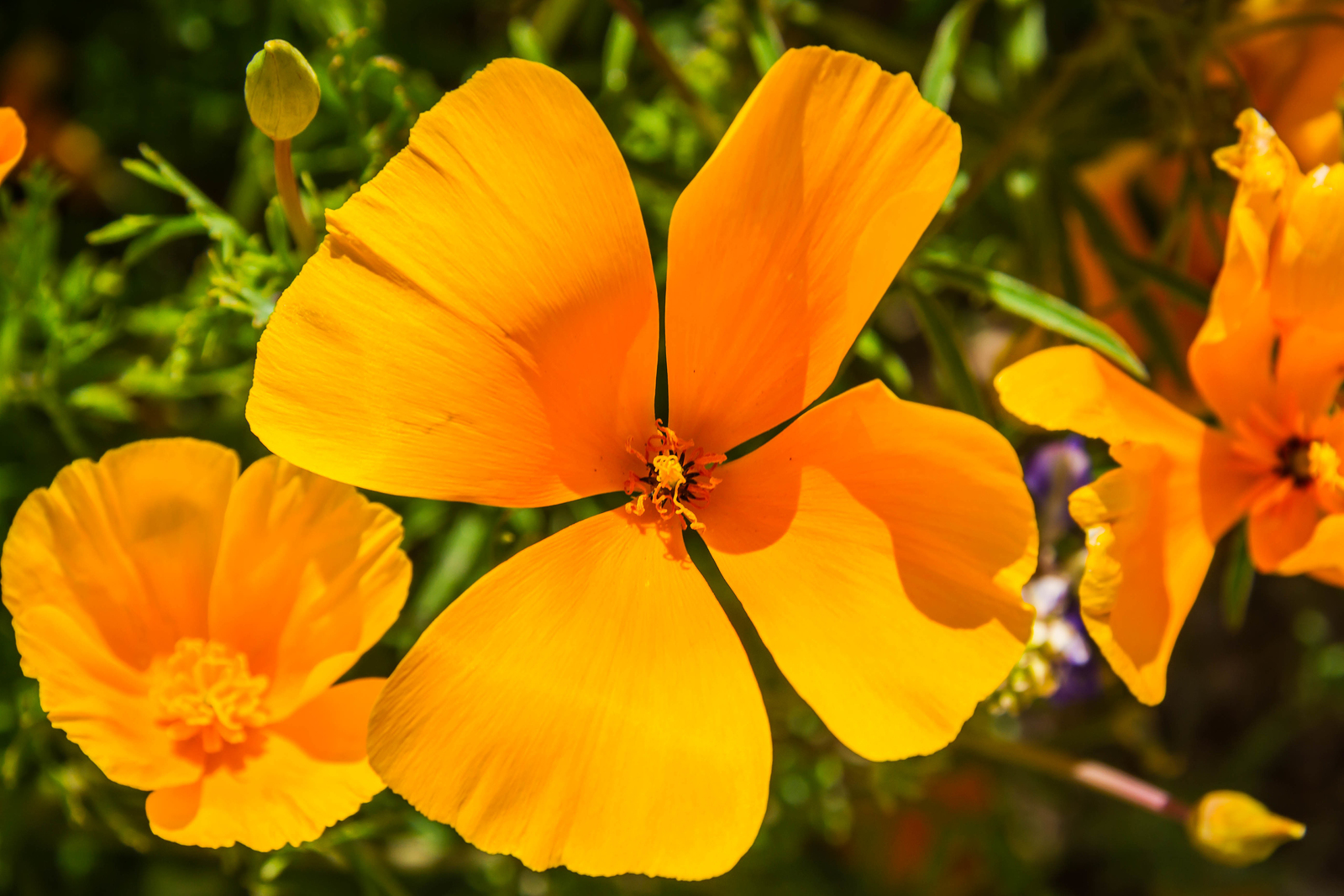 Eschscholzia californica (California poppy): Masses of saucer-shaped brilliant orange flowers on low-spreading plants with finely cut leaves. American goldfinches, cardinals, chickadees, evening grosbeaks, finches, and titmice consume the seeds.
Eschscholzia californica (California poppy): Masses of saucer-shaped brilliant orange flowers on low-spreading plants with finely cut leaves. American goldfinches, cardinals, chickadees, evening grosbeaks, finches, and titmice consume the seeds.
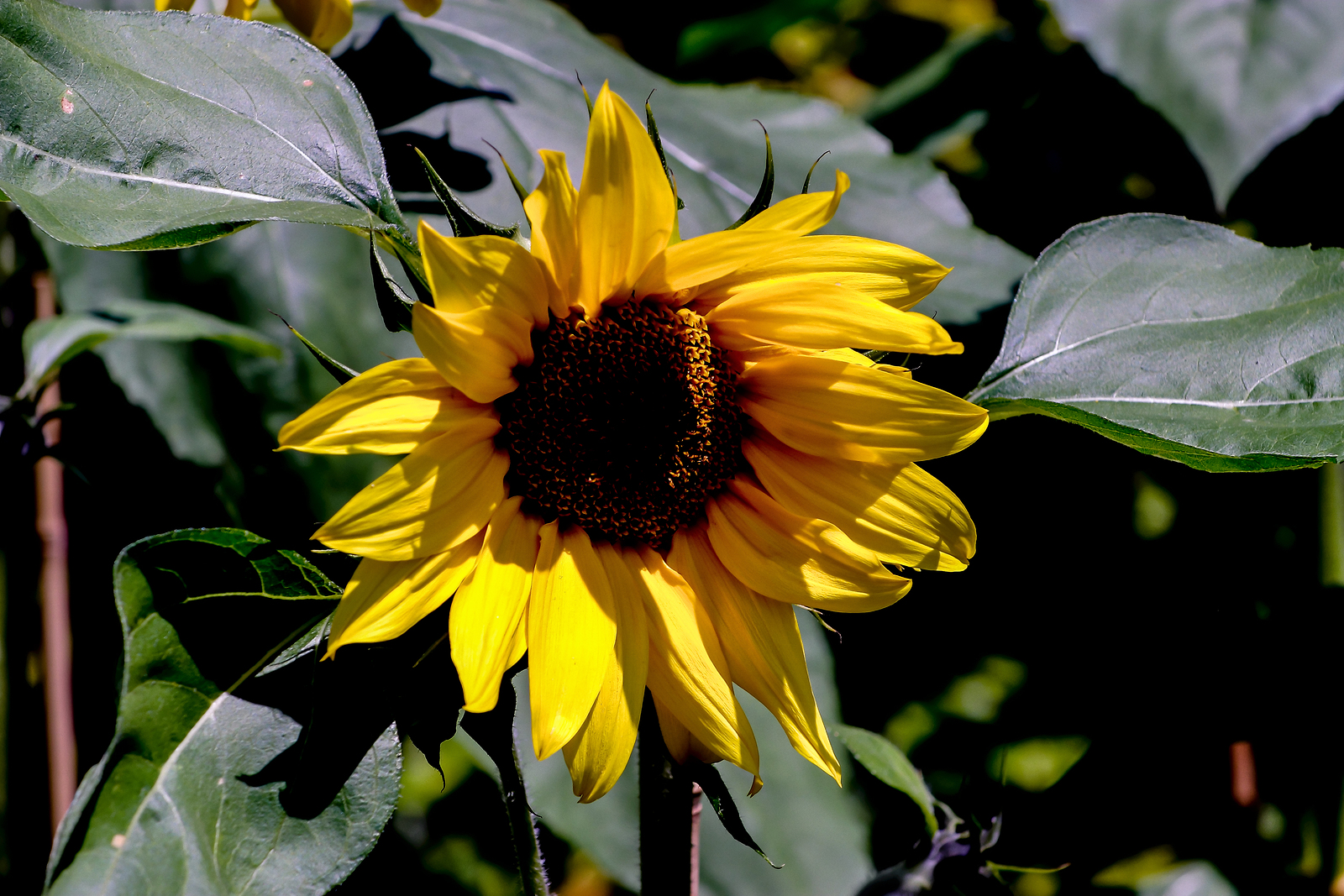 Helianthus spp. (sunflower): Sturdy plants with bright, bold flowers. Both low-growing varieties and tall ones. Seeds attract northern cardinals, tufted titmice, mourning doves, gray catbirds, evening grosbeaks, boat-tailed and common grackles, bushtits, house finches, pine siskins, black-billed magpies and all species of chickadees, nuthatches, and jays.
Helianthus spp. (sunflower): Sturdy plants with bright, bold flowers. Both low-growing varieties and tall ones. Seeds attract northern cardinals, tufted titmice, mourning doves, gray catbirds, evening grosbeaks, boat-tailed and common grackles, bushtits, house finches, pine siskins, black-billed magpies and all species of chickadees, nuthatches, and jays.
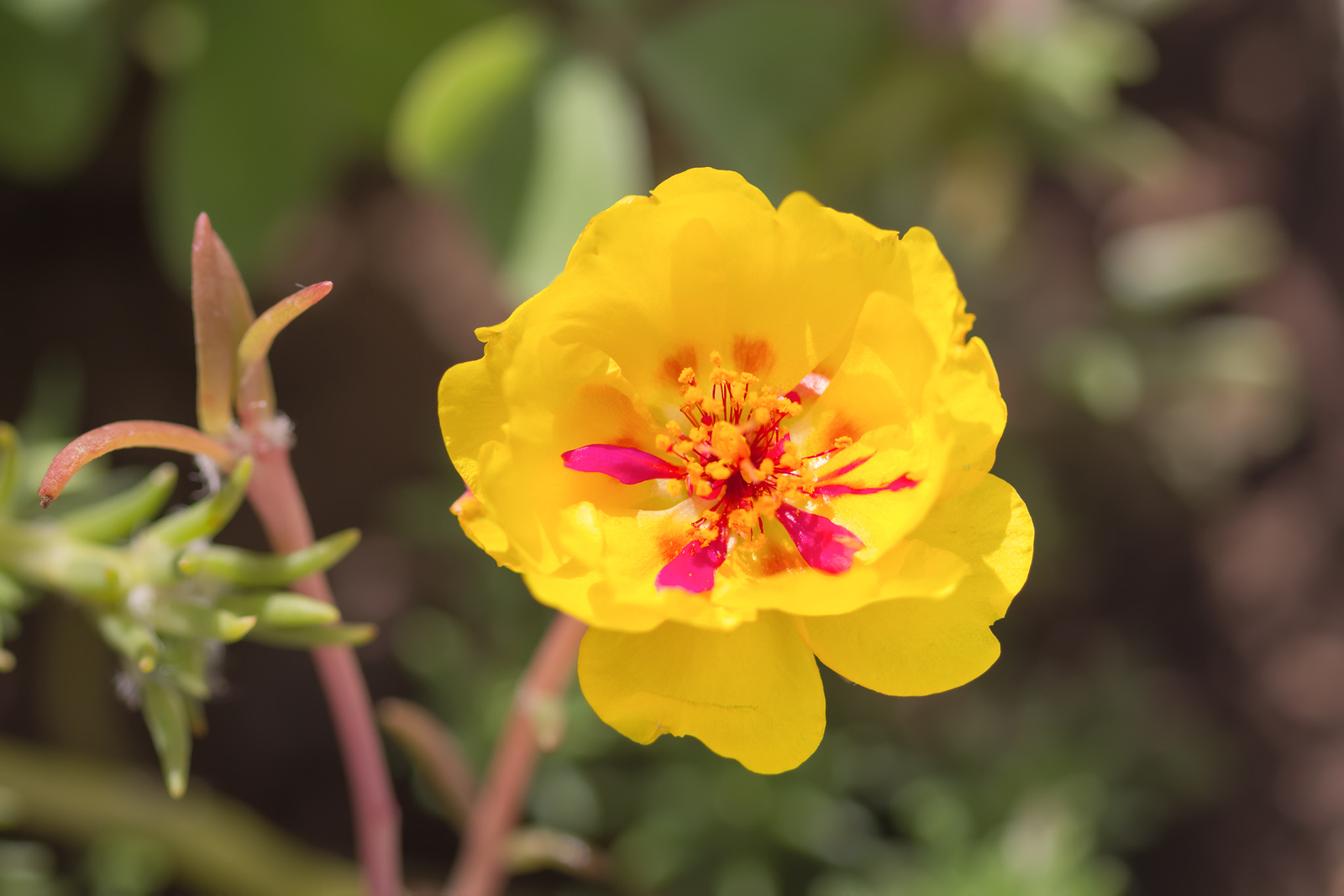 Portulaca grandiflora (moss rose): Colorful ground-hugging plant with succulents narrow leaves and single to double flowers; profuse blooms open when the sun shines. Finches, sparrows, and robins are among the many birds that eat moss rose seeds.
Portulaca grandiflora (moss rose): Colorful ground-hugging plant with succulents narrow leaves and single to double flowers; profuse blooms open when the sun shines. Finches, sparrows, and robins are among the many birds that eat moss rose seeds.
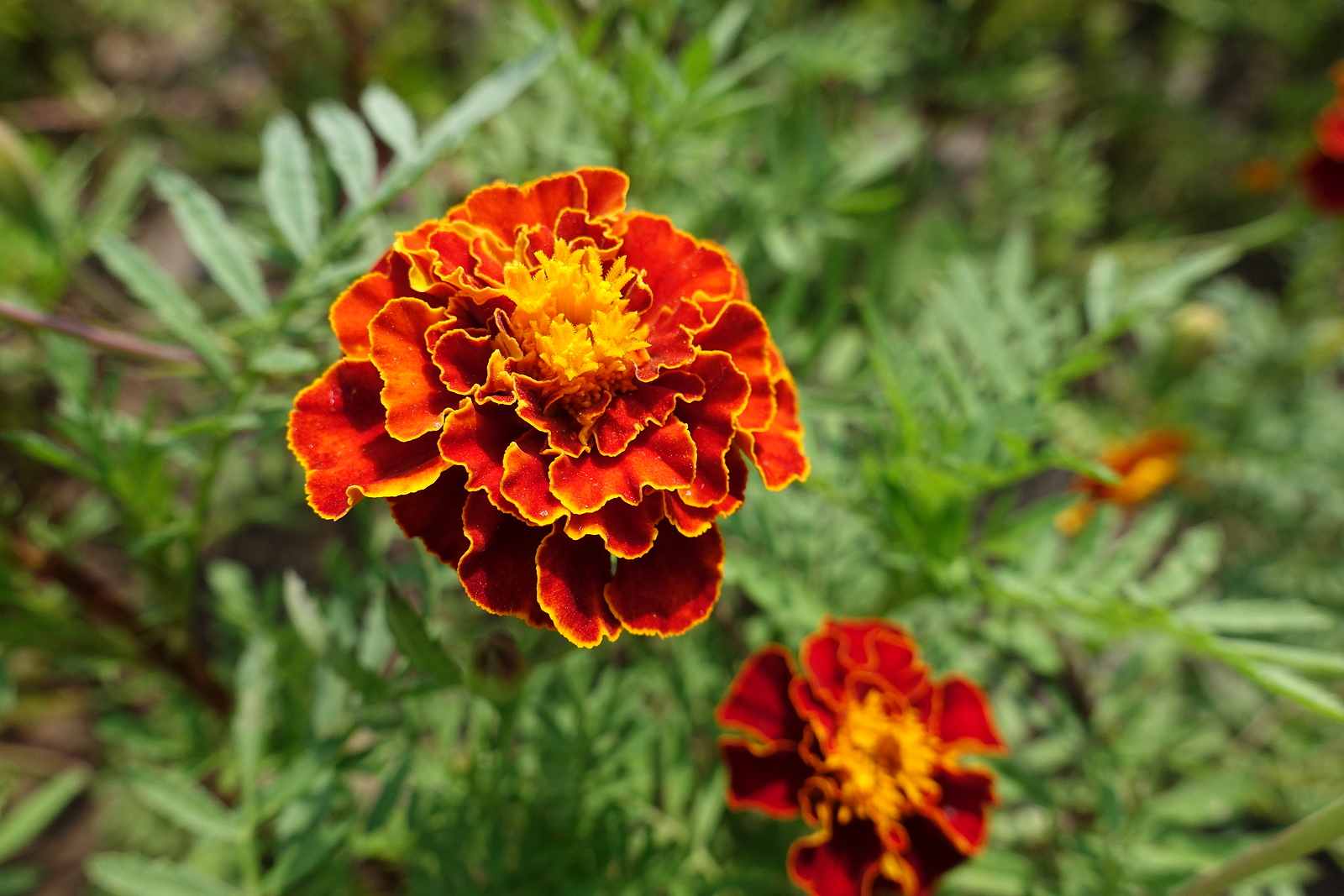 Tagetes erecta (African marigold): Long-flowering summer annuals with single, semi-double, or double flowers that are often bicolored. Seeds are eaten by sparrows, blackbirds, bluebirds, robins, and thrushes. Other insectivorous birds also visit marigolds.
Tagetes erecta (African marigold): Long-flowering summer annuals with single, semi-double, or double flowers that are often bicolored. Seeds are eaten by sparrows, blackbirds, bluebirds, robins, and thrushes. Other insectivorous birds also visit marigolds.
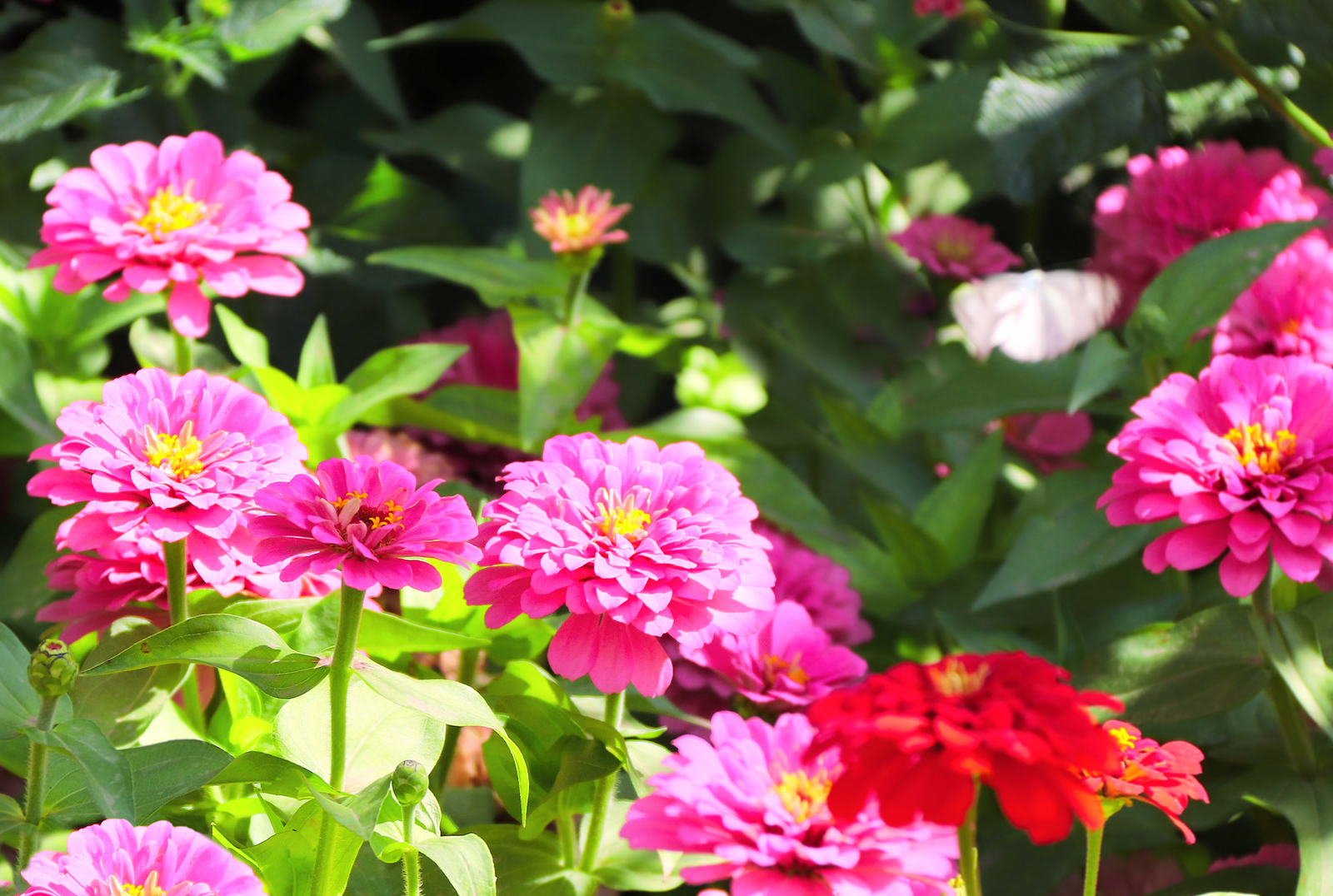 Zinnia elagans (common zinnia): Colorful single or double daisylike flowers with petals oten quilled, sometimes bicolored. Wide range of sizes and long blooming. Sparrows and goldfinches that can keep well-fed visiting zinnias and collected their seeds.
Zinnia elagans (common zinnia): Colorful single or double daisylike flowers with petals oten quilled, sometimes bicolored. Wide range of sizes and long blooming. Sparrows and goldfinches that can keep well-fed visiting zinnias and collected their seeds.
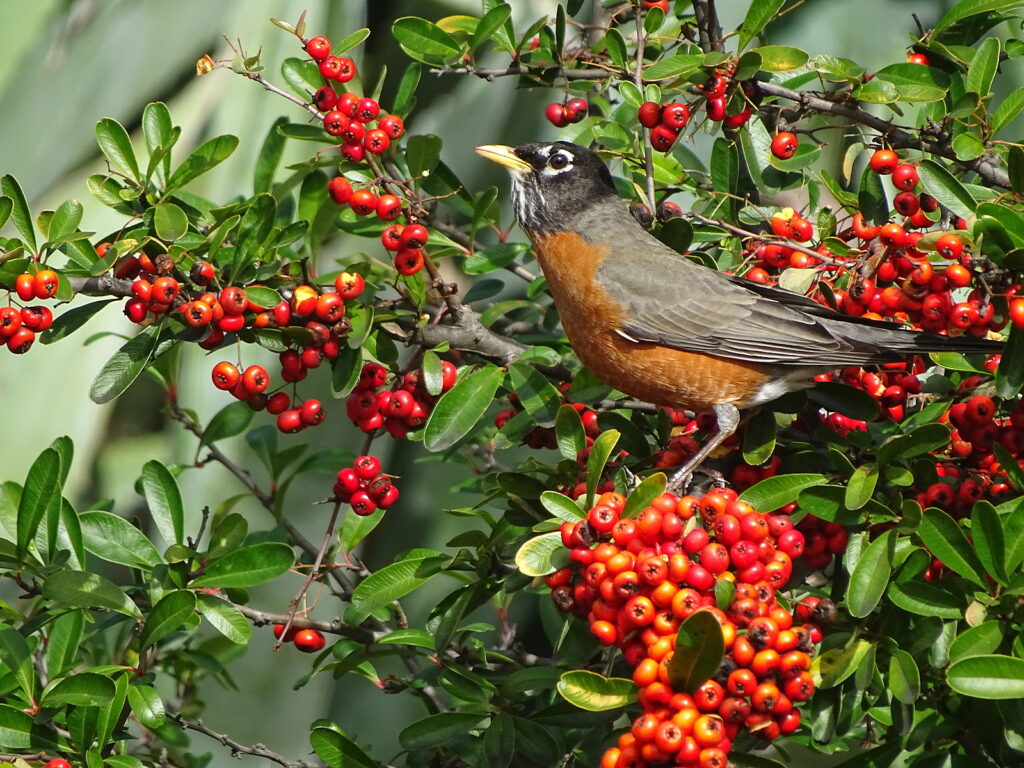
Perennials
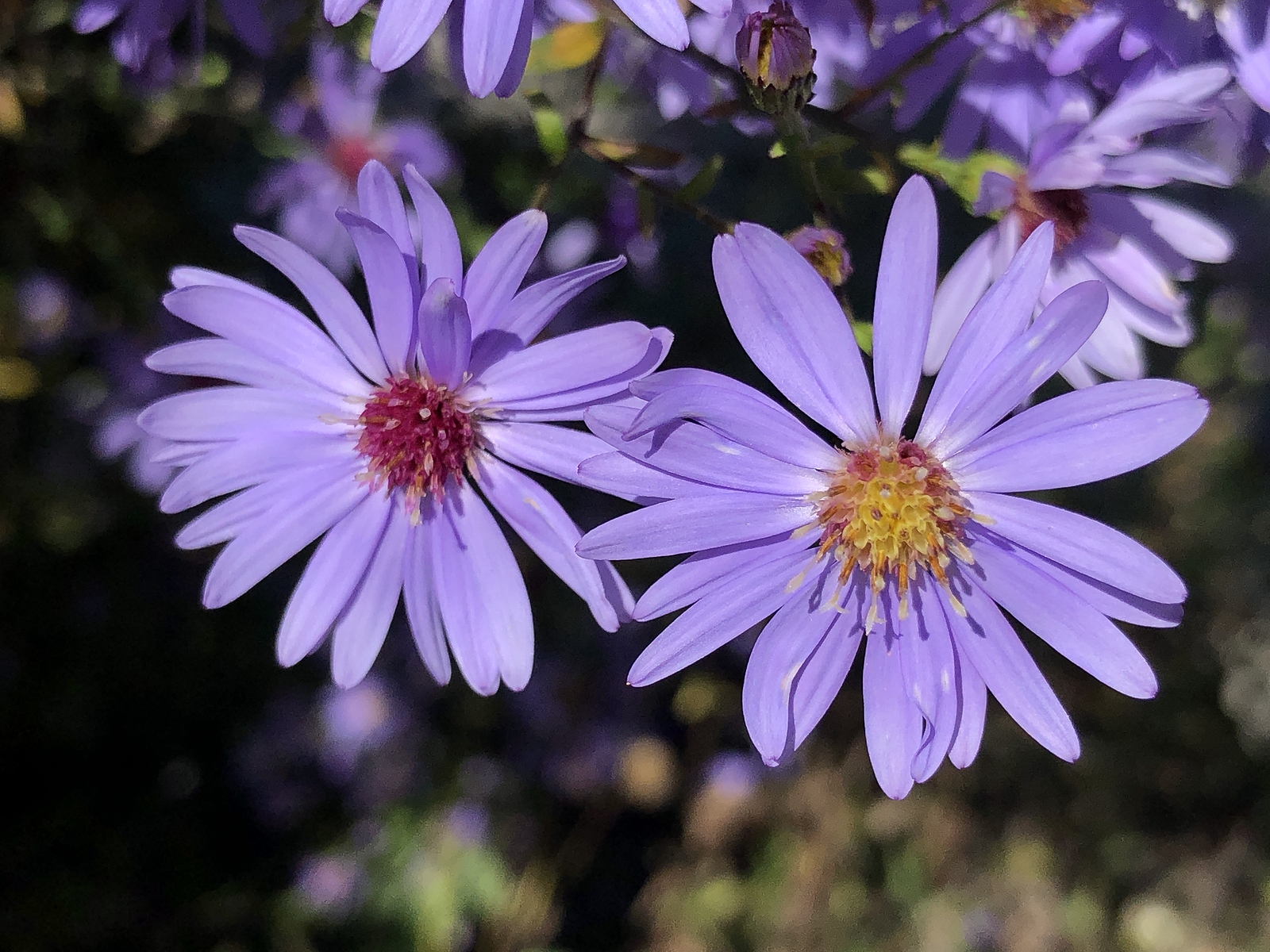 Aster spp. (aster): Colorful fall-blooming plant with profuse daisy-like flowers. Aster seeds attract cardinals, chickadees, goldfinches, indigo buntings, nuthatches, sparrows, and towhees.
Aster spp. (aster): Colorful fall-blooming plant with profuse daisy-like flowers. Aster seeds attract cardinals, chickadees, goldfinches, indigo buntings, nuthatches, sparrows, and towhees.
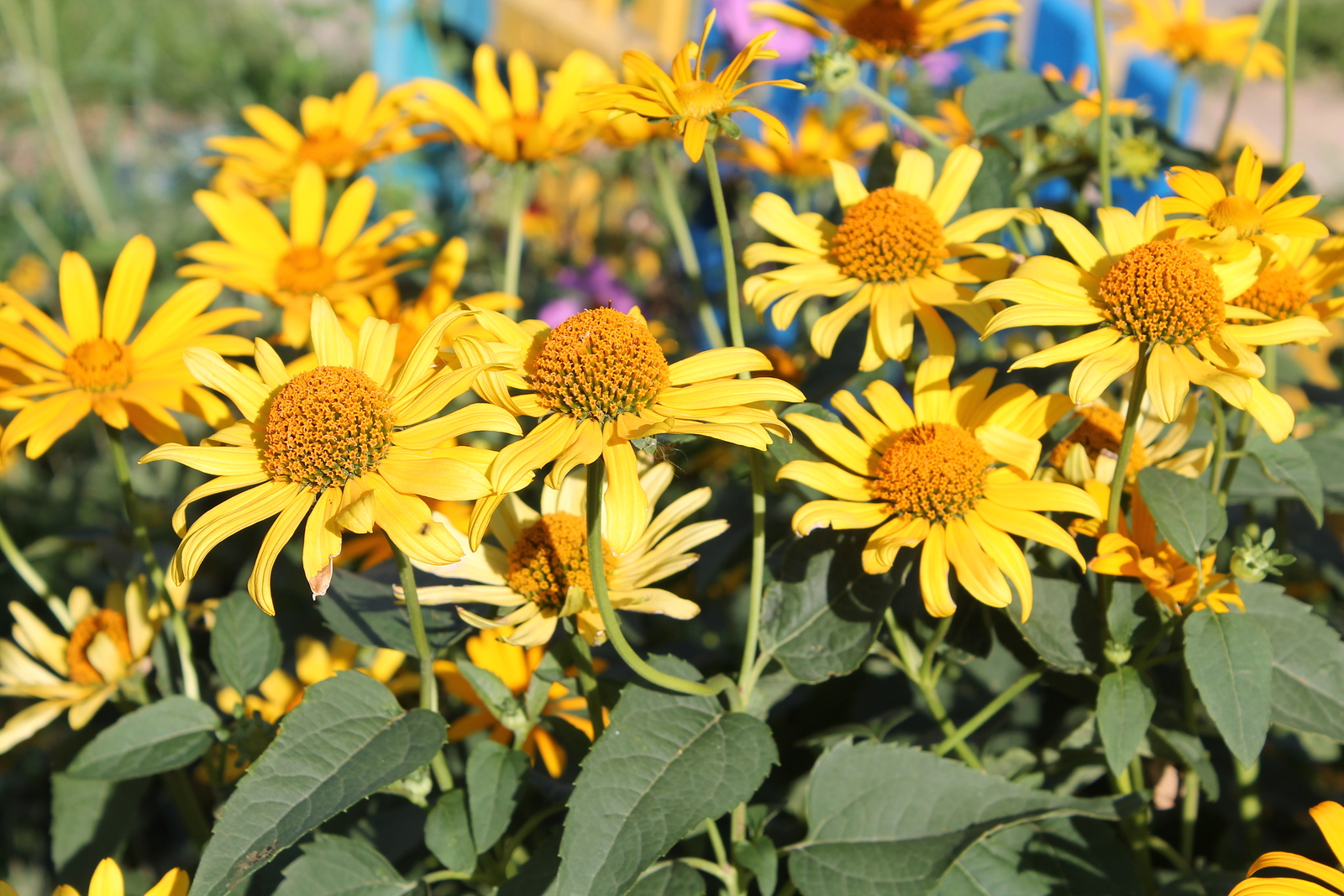 Coreopsis spp. (coreopsis): Yellow and orange daisy-like flowers bloom in profusion over a long period in summer. Seeds attract sparrows, chickadees, cardinals, goldfinches, and other seed-eating birds.
Coreopsis spp. (coreopsis): Yellow and orange daisy-like flowers bloom in profusion over a long period in summer. Seeds attract sparrows, chickadees, cardinals, goldfinches, and other seed-eating birds.
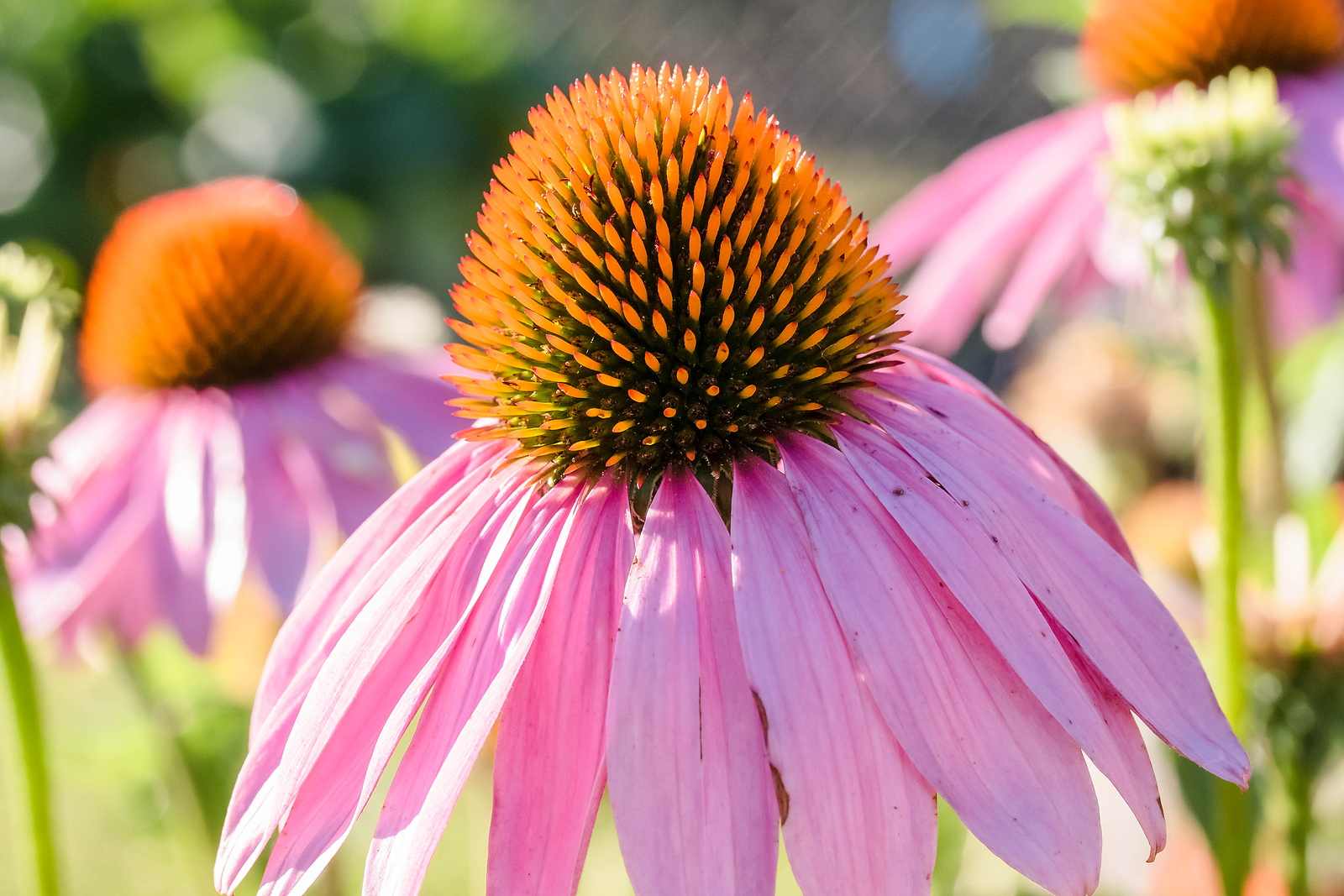 Echinacea purpurea (purple coneflower): long-lasting, large daisy-like flowers with rounded cone-shaped centers on long stiff stems bloom in mid to late summer. American goldfinch and the pine siskin eat the seeds.
Echinacea purpurea (purple coneflower): long-lasting, large daisy-like flowers with rounded cone-shaped centers on long stiff stems bloom in mid to late summer. American goldfinch and the pine siskin eat the seeds.
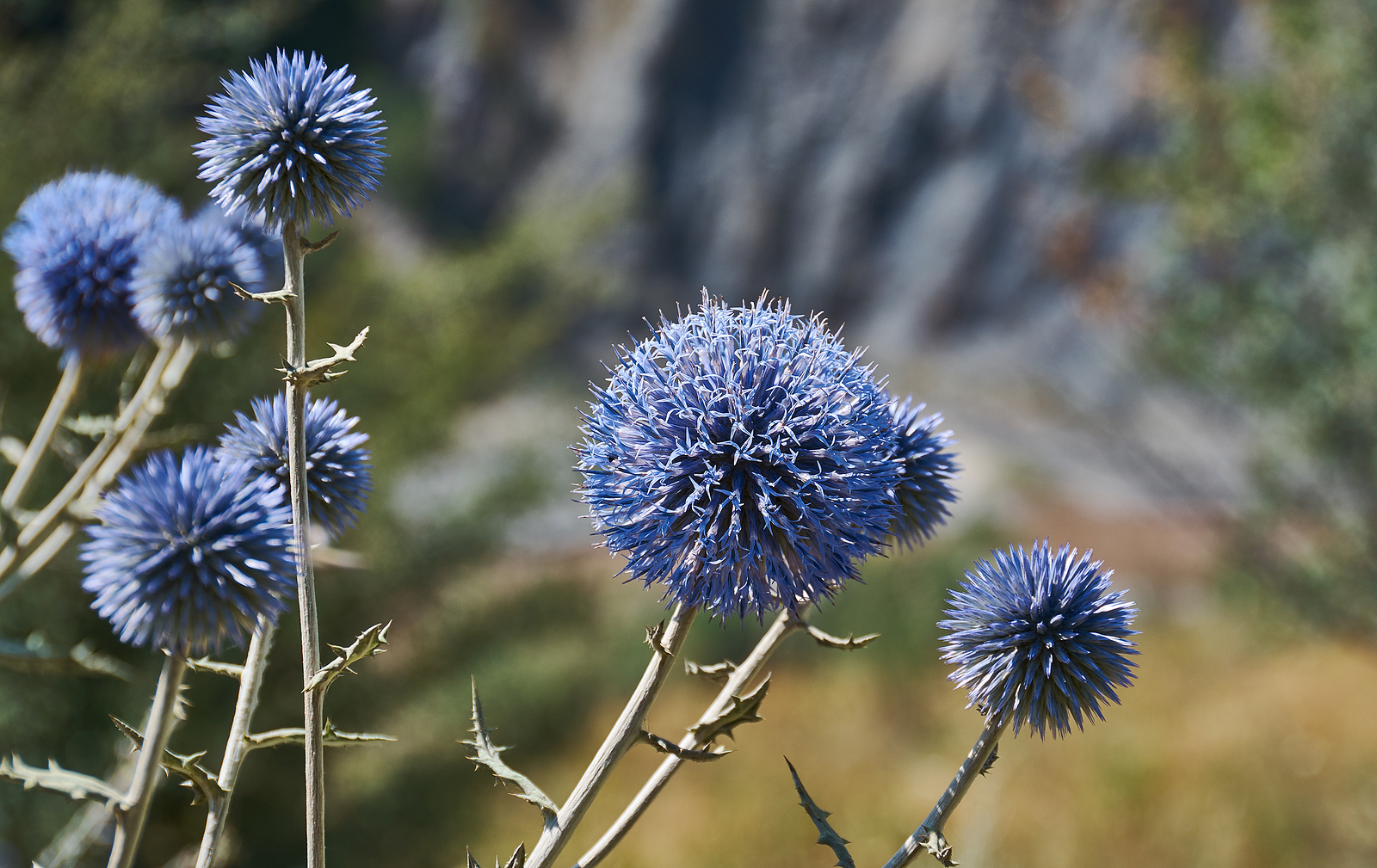 Echinops ritro (globe thistle): Globular flower heads in shades of blue are borne in late summer above dark green thistle-like foliage. The flowers slowly fade in color and the seeds are especially popular with goldfinches.
Echinops ritro (globe thistle): Globular flower heads in shades of blue are borne in late summer above dark green thistle-like foliage. The flowers slowly fade in color and the seeds are especially popular with goldfinches.
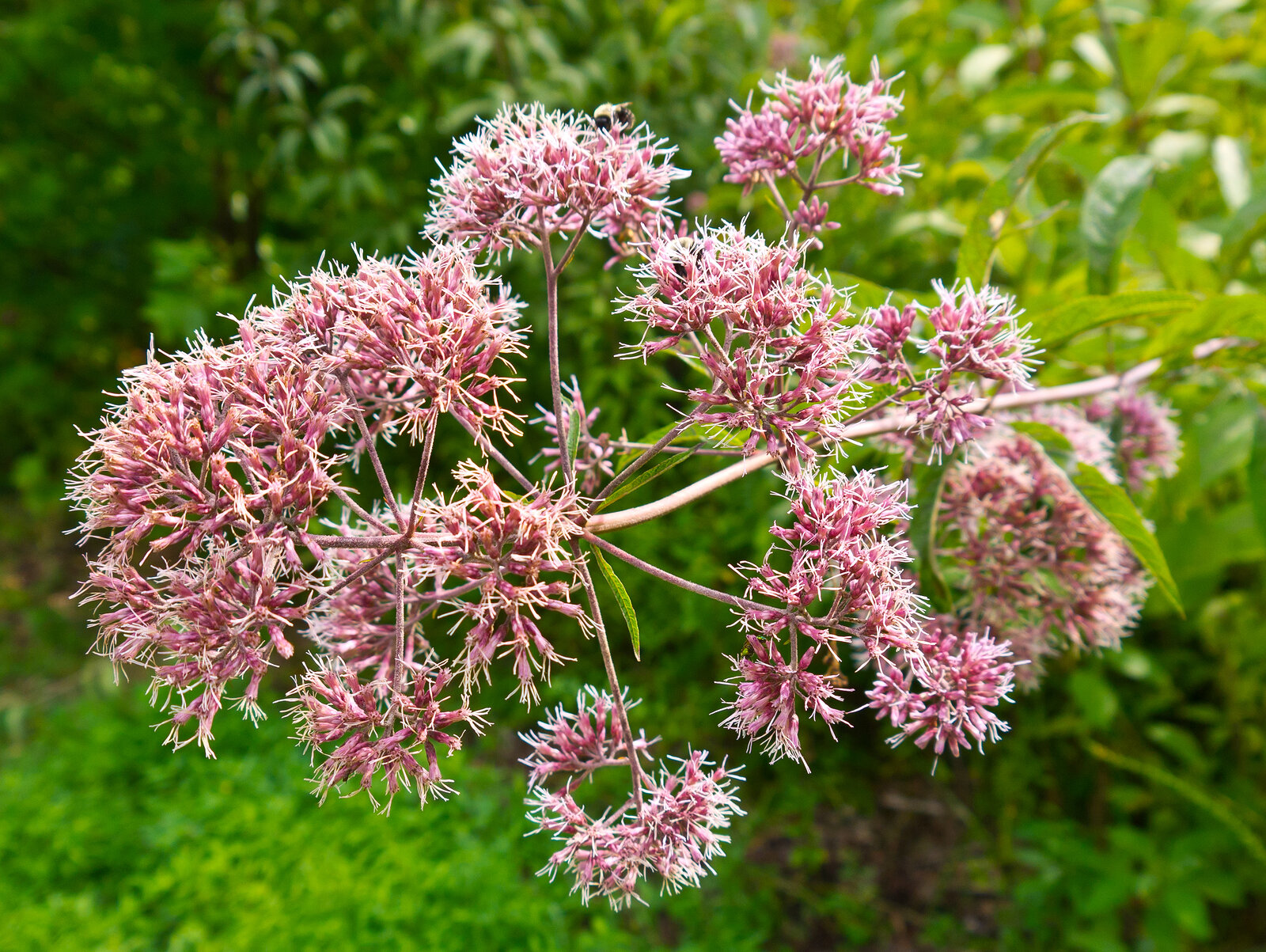 Eupatorium spp. (Joe Pye weed): Medium-size to towering perennials with large clusters of small flower heads at the tops of leaf stems. Chickadees, wrens, titmice, and juncos eat the seeds as well as using the fluff for building warm nests.
Eupatorium spp. (Joe Pye weed): Medium-size to towering perennials with large clusters of small flower heads at the tops of leaf stems. Chickadees, wrens, titmice, and juncos eat the seeds as well as using the fluff for building warm nests.
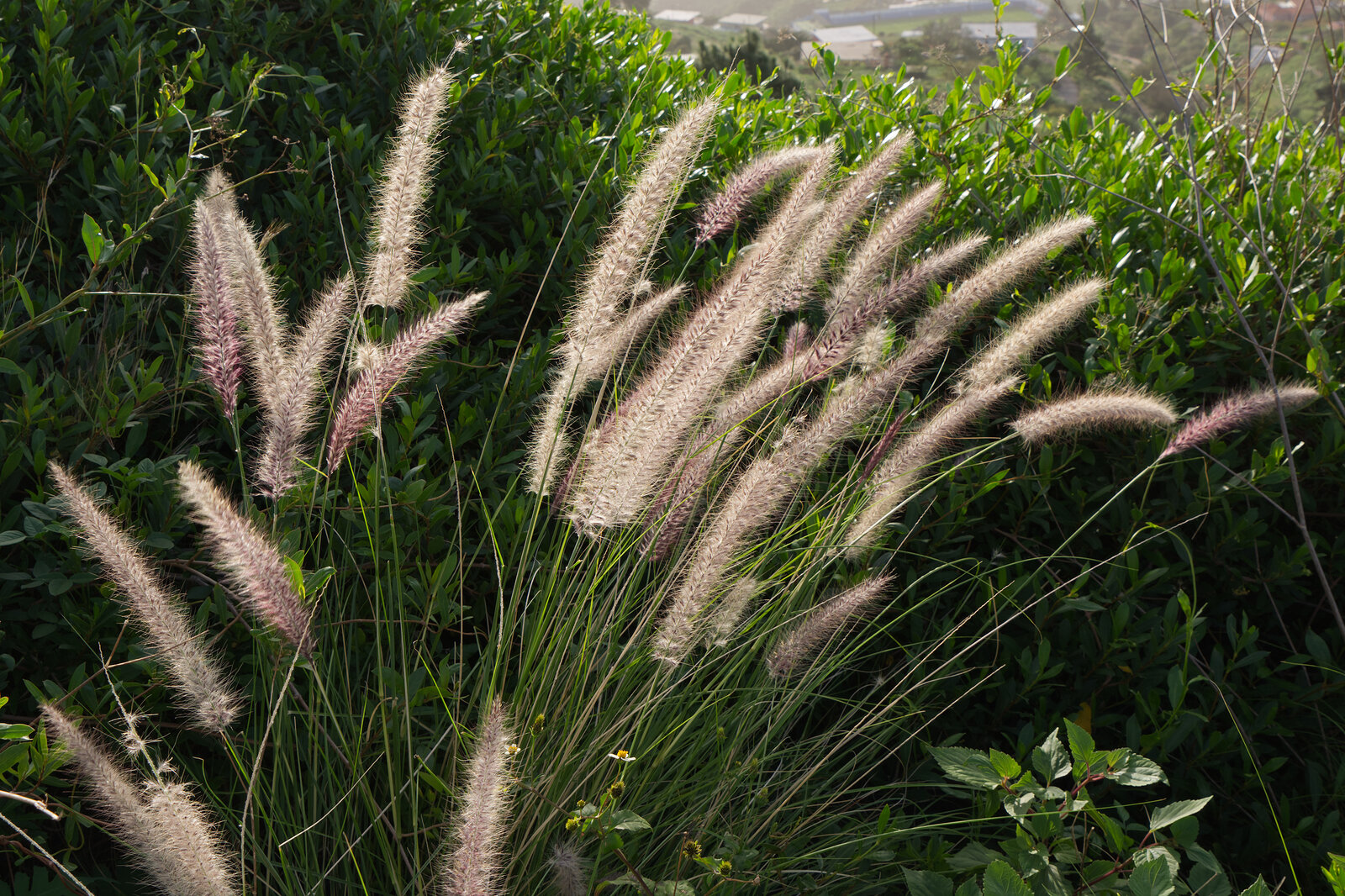 Ornamental grasses: Birds are attracted to seed heads of ornamental grasses in late summer and autumn. Ornamental grasses include Arrhenatherum, bulbous oat grass; Arundo, giant reed; Bouteloua, blue grama grass; Briza, rattlesnake grass; Calamagrostis, feather reed grass; Casmanthium, sea oats; Cortaderia, pampa grass; Deschampsia, hair grass; Festuca, fescue; Hakonechloa, Japanese forest grass; Miscanthus, eulalia grass; Molinia, purple moor grass; Muhlenbergia, deer grass; Panicum, switch grass, Pennisetum, fountain grass (photo); Phlaris, ribbon grass; Stipa, feather grass.
Ornamental grasses: Birds are attracted to seed heads of ornamental grasses in late summer and autumn. Ornamental grasses include Arrhenatherum, bulbous oat grass; Arundo, giant reed; Bouteloua, blue grama grass; Briza, rattlesnake grass; Calamagrostis, feather reed grass; Casmanthium, sea oats; Cortaderia, pampa grass; Deschampsia, hair grass; Festuca, fescue; Hakonechloa, Japanese forest grass; Miscanthus, eulalia grass; Molinia, purple moor grass; Muhlenbergia, deer grass; Panicum, switch grass, Pennisetum, fountain grass (photo); Phlaris, ribbon grass; Stipa, feather grass.
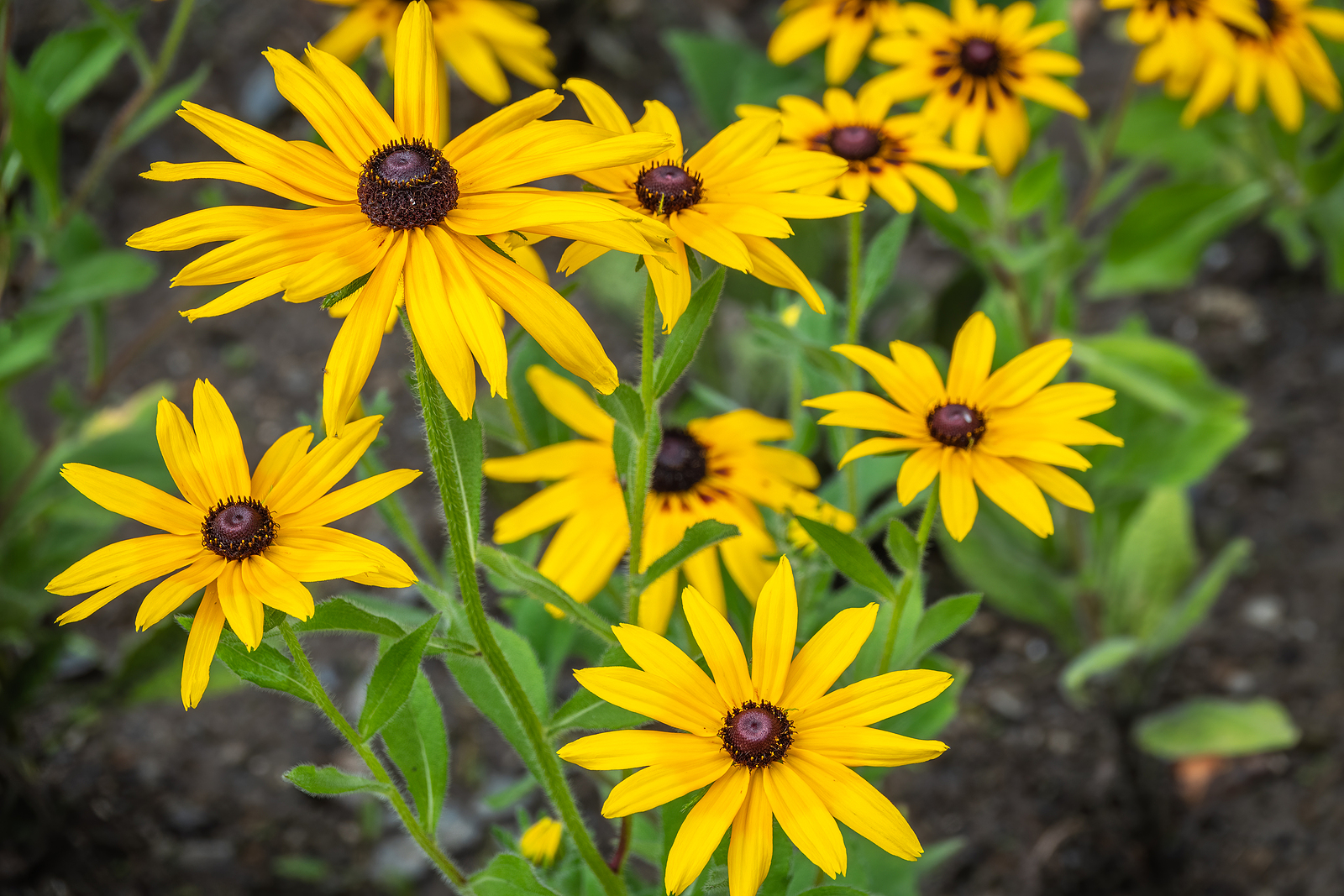 Rudbeckia spp. (coneflower): Showy, single or double, daisy-like yellow or orange flowers with black centers bloom over a long period in mid to late summer. American goldfinches, chickadees, cardinals, nuthatches, and sparrows eat the seeds.
Rudbeckia spp. (coneflower): Showy, single or double, daisy-like yellow or orange flowers with black centers bloom over a long period in mid to late summer. American goldfinches, chickadees, cardinals, nuthatches, and sparrows eat the seeds.
 Scabiosa caucastica (pincushion flower): Globular heads of blue, white, or pink flowers bloom from early summer to fall. Native sparrows, finches, and other small birds forage for Scabiosa seeds.,
Scabiosa caucastica (pincushion flower): Globular heads of blue, white, or pink flowers bloom from early summer to fall. Native sparrows, finches, and other small birds forage for Scabiosa seeds.,
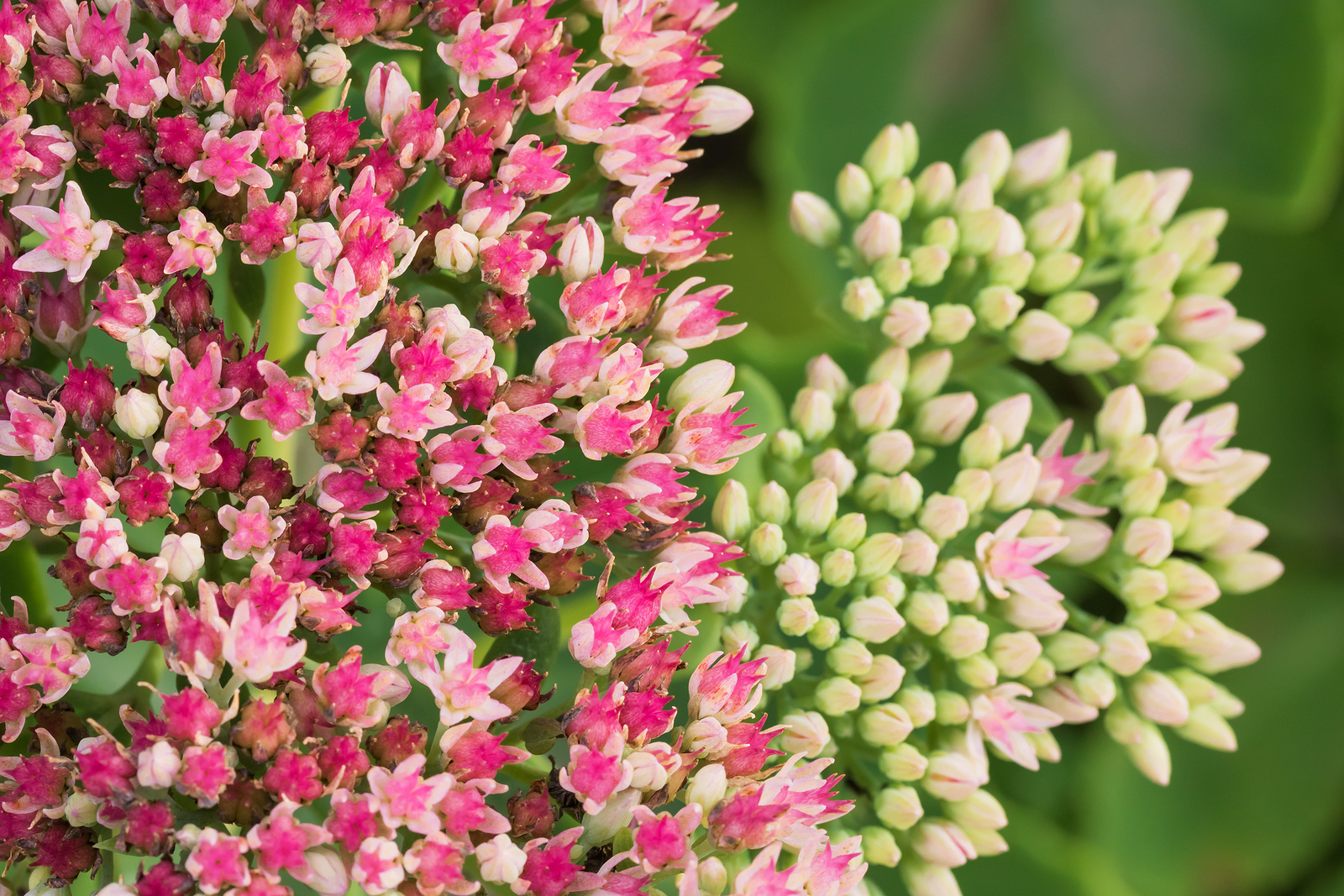 Sedum spp. (sedum or stonecrop): Fleshy-leaved plants with large clusters of small rosy pink flowers in late summer or early fall. Drying flower heads will attract almost all seed-earing birds.
Sedum spp. (sedum or stonecrop): Fleshy-leaved plants with large clusters of small rosy pink flowers in late summer or early fall. Drying flower heads will attract almost all seed-earing birds.
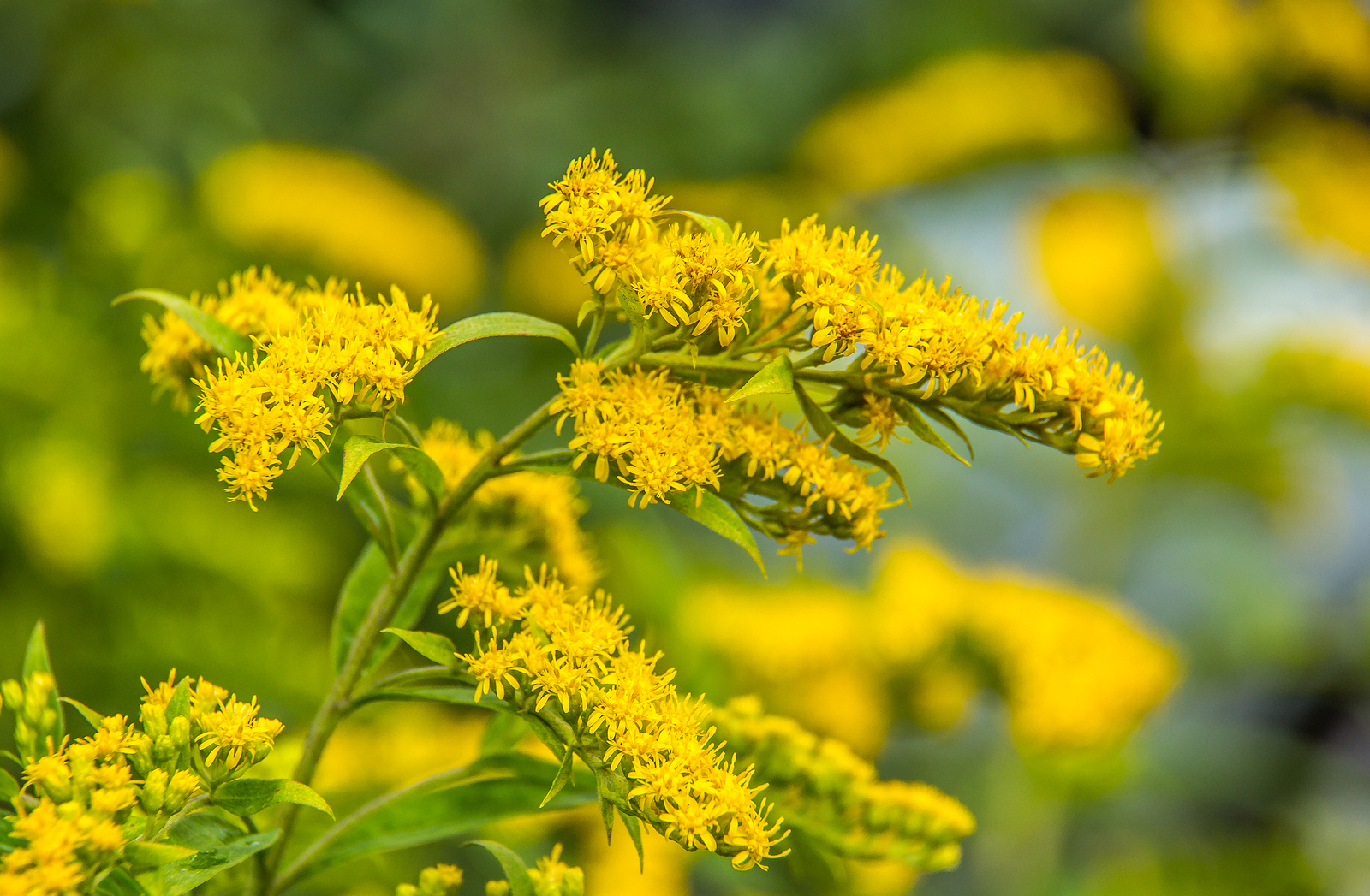 Solidago spp. (goldenrod): Tough plants with small yellow flowers large branching clusters from mid-summer into fall. Seeds attract American goldfinch, black-capped chickadee, Carolina wren, dark-eyed junco, indigo bunting, pine siskin, tufted titmouse, and white-throated sparrow.
Solidago spp. (goldenrod): Tough plants with small yellow flowers large branching clusters from mid-summer into fall. Seeds attract American goldfinch, black-capped chickadee, Carolina wren, dark-eyed junco, indigo bunting, pine siskin, tufted titmouse, and white-throated sparrow.
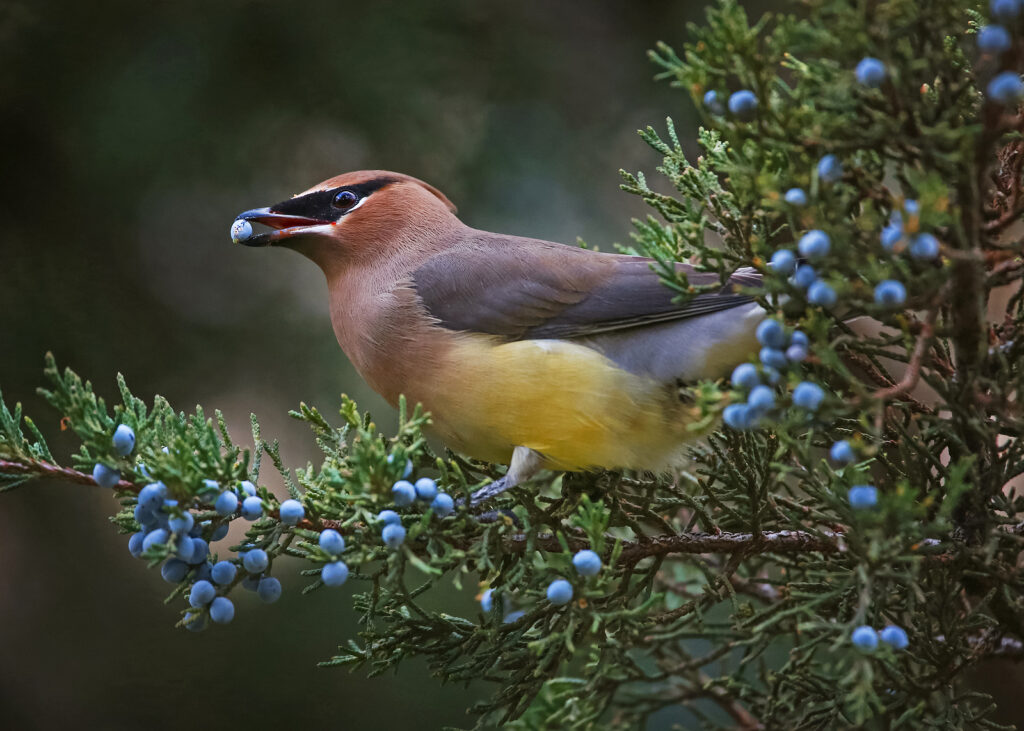
Shurbs
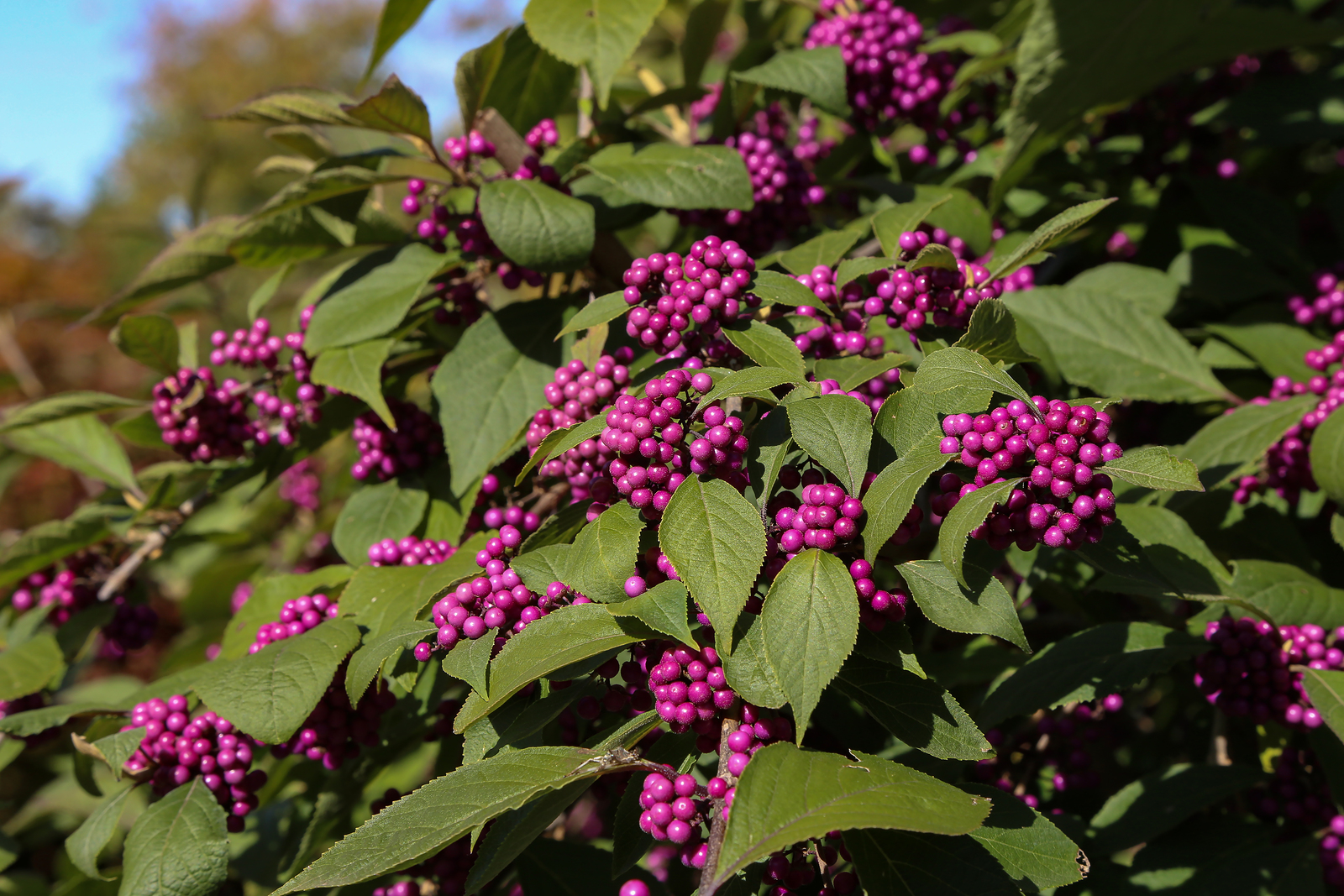 Callicarpa spp. (beautyberry): Tiny tubular flowers in clusters open during summer, but often obscured by folige. In fall berry cluster put on a good display after leaves turn yellow and top. Berries are an important food source for many birds, such as bobwhite quail, robins, cardinals, catbirds, finches, mockingbirds, thrashers, and towhees. Other animals that eat the fruit include armadillos, raccoons, opossums, squirrels, and gray foxes. Grows best in Zones5-8.
Callicarpa spp. (beautyberry): Tiny tubular flowers in clusters open during summer, but often obscured by folige. In fall berry cluster put on a good display after leaves turn yellow and top. Berries are an important food source for many birds, such as bobwhite quail, robins, cardinals, catbirds, finches, mockingbirds, thrashers, and towhees. Other animals that eat the fruit include armadillos, raccoons, opossums, squirrels, and gray foxes. Grows best in Zones5-8.
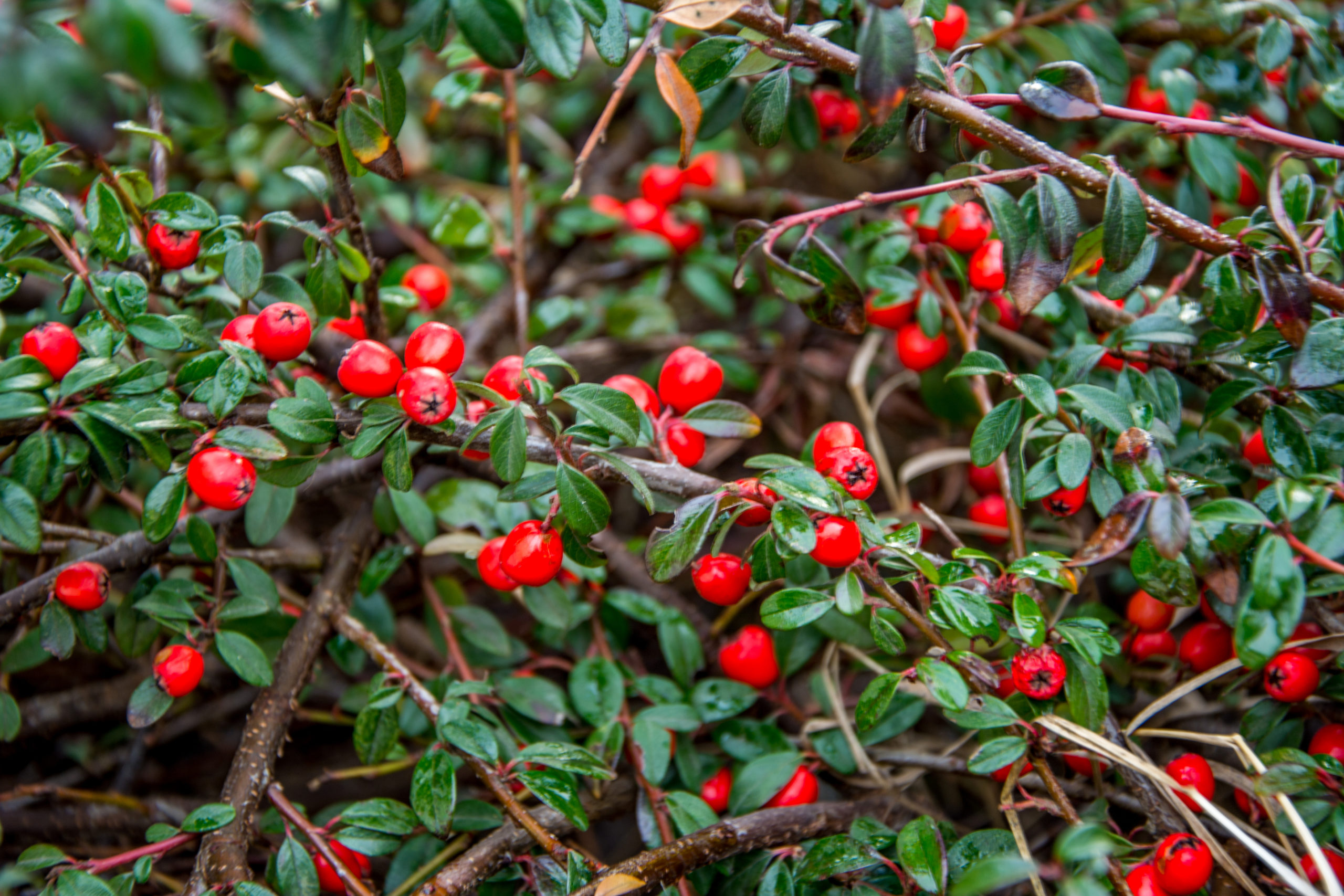 Cotoneaster spp. (cotoneaster): Small white or pinkish flowers appear in spring or summer. Foliage and small red to black fruit make a showy display in autumn and usually remain on plants through winter. Berries attract blackbirds, waxwings, robins, bullfinches, blackcaps, and thrushes. Grows best in Zones 4-8.
Cotoneaster spp. (cotoneaster): Small white or pinkish flowers appear in spring or summer. Foliage and small red to black fruit make a showy display in autumn and usually remain on plants through winter. Berries attract blackbirds, waxwings, robins, bullfinches, blackcaps, and thrushes. Grows best in Zones 4-8.
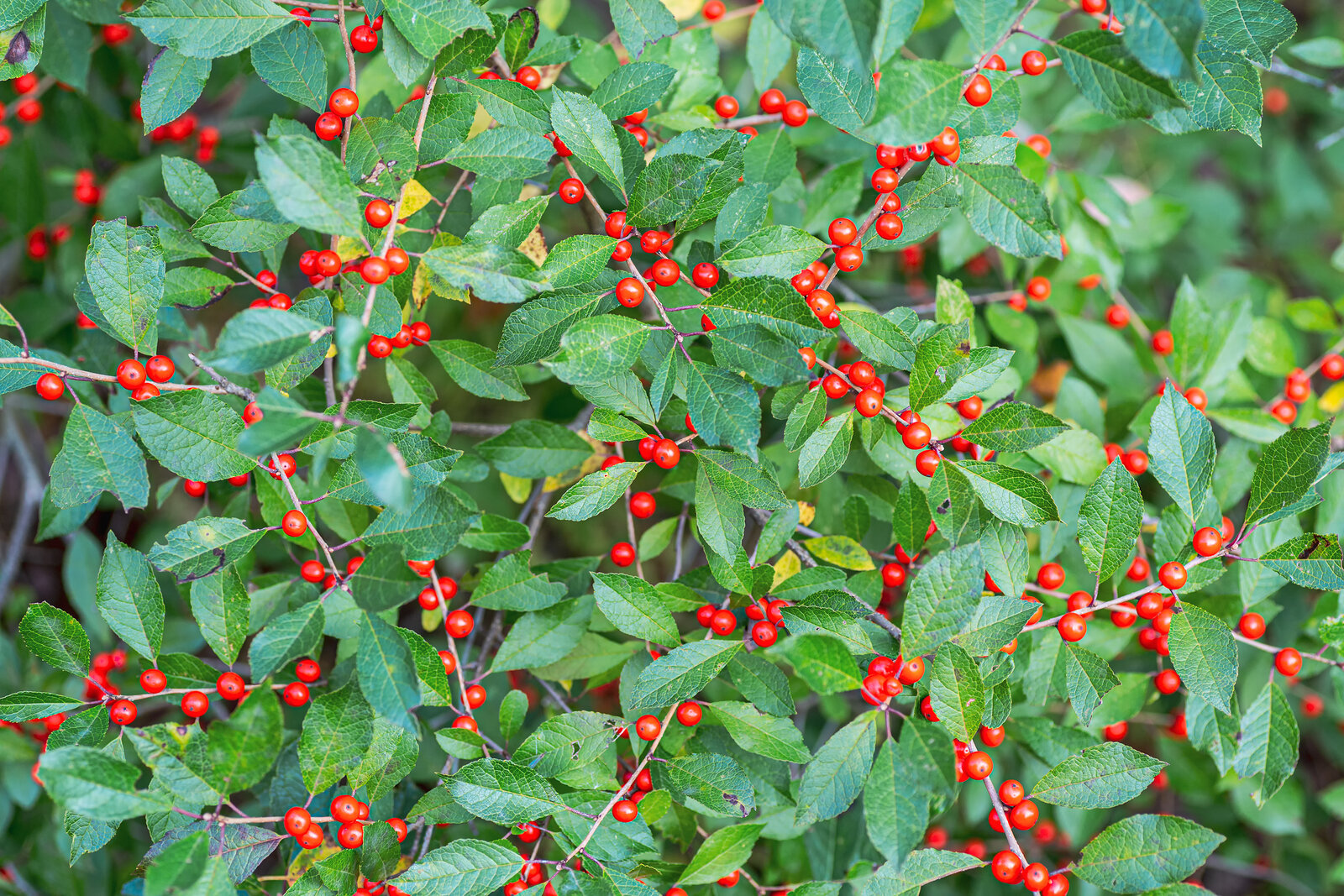 Ilex X meserveae (hybrid holly): Greenish or white flowers grow in the juncture of leaf and stems are seldom noticeable. Berry-like fruits are frequently spectacular but are borne only on female plants, so be sure to plant both male and female plants in close proximity. Fruits attract song thrushes, redwings, fieldfares, and blackbirds. Grows best in Zones6-9.
Ilex X meserveae (hybrid holly): Greenish or white flowers grow in the juncture of leaf and stems are seldom noticeable. Berry-like fruits are frequently spectacular but are borne only on female plants, so be sure to plant both male and female plants in close proximity. Fruits attract song thrushes, redwings, fieldfares, and blackbirds. Grows best in Zones6-9.
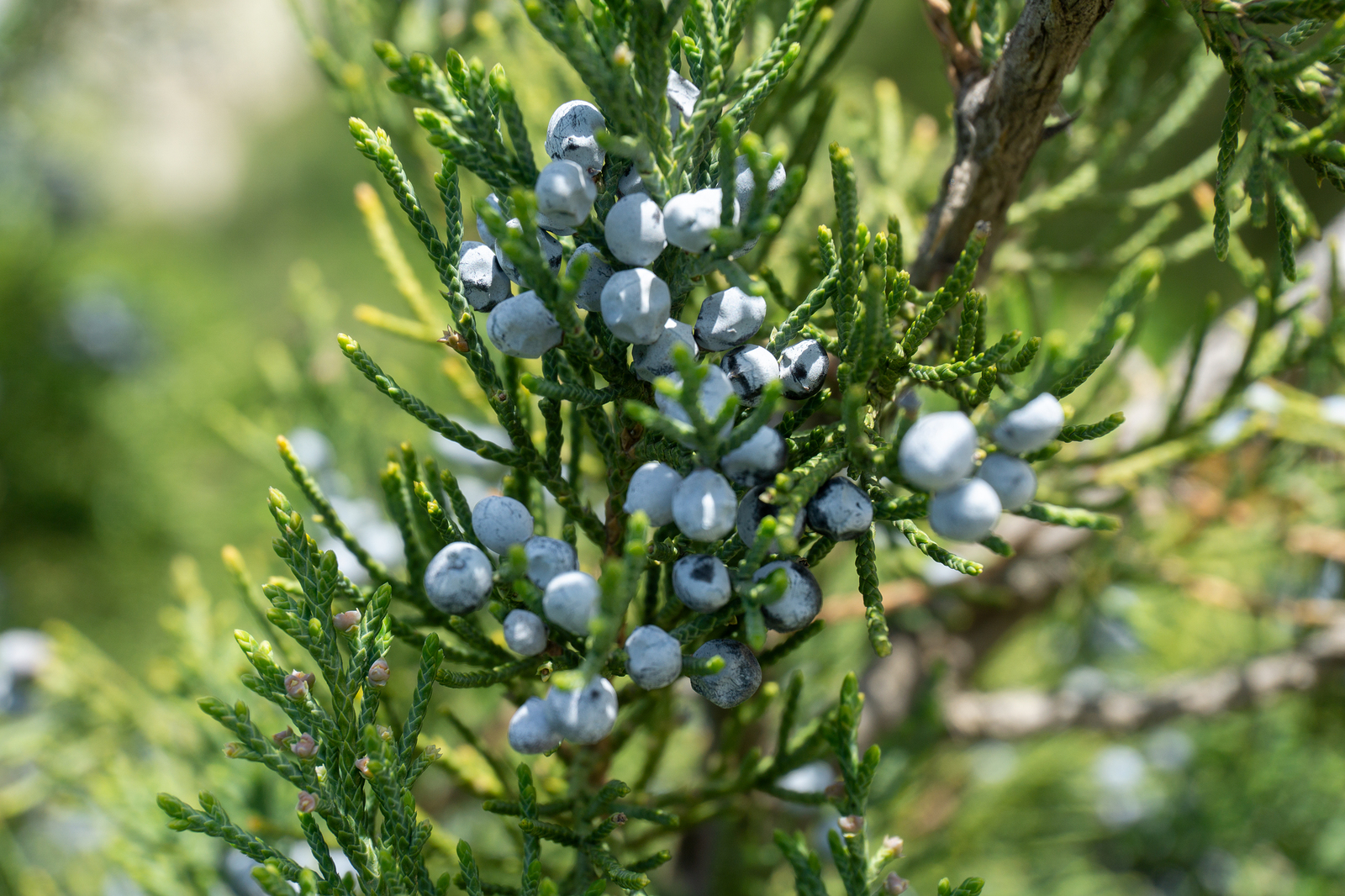 Juniperus spp. (juniper): Several species of this handsome plant with a needle or scalelike foliage. Female plants set small blue berry-like fruits that may take up to three years to mature. Fruits attract everything from eastern bluebirds and evening grosbeaks to wild turkeys and sharp-tailed grouse. Grows best in Zones 3-9.
Juniperus spp. (juniper): Several species of this handsome plant with a needle or scalelike foliage. Female plants set small blue berry-like fruits that may take up to three years to mature. Fruits attract everything from eastern bluebirds and evening grosbeaks to wild turkeys and sharp-tailed grouse. Grows best in Zones 3-9.
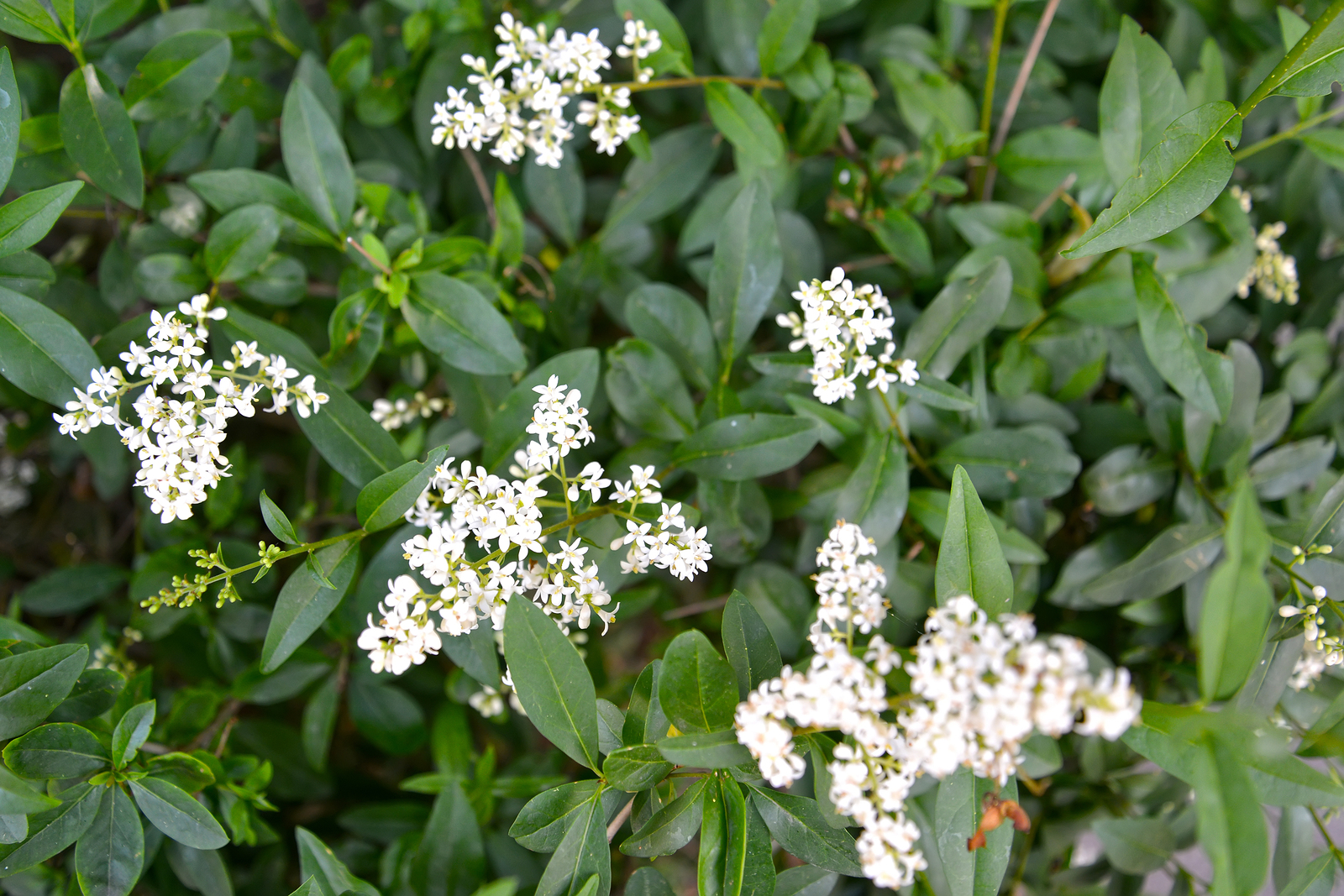 Ligustrum spp. (privet): Glossy, dark green leave and waxy white flower clusters in summer. Blue or black fruits are berry-like and sometimes inconspicuous, but they attract more than 40 species of birds, including hermit thrushes, cardinals, woodpeckers, and robins. Grows best in Zones 5-9.
Ligustrum spp. (privet): Glossy, dark green leave and waxy white flower clusters in summer. Blue or black fruits are berry-like and sometimes inconspicuous, but they attract more than 40 species of birds, including hermit thrushes, cardinals, woodpeckers, and robins. Grows best in Zones 5-9.
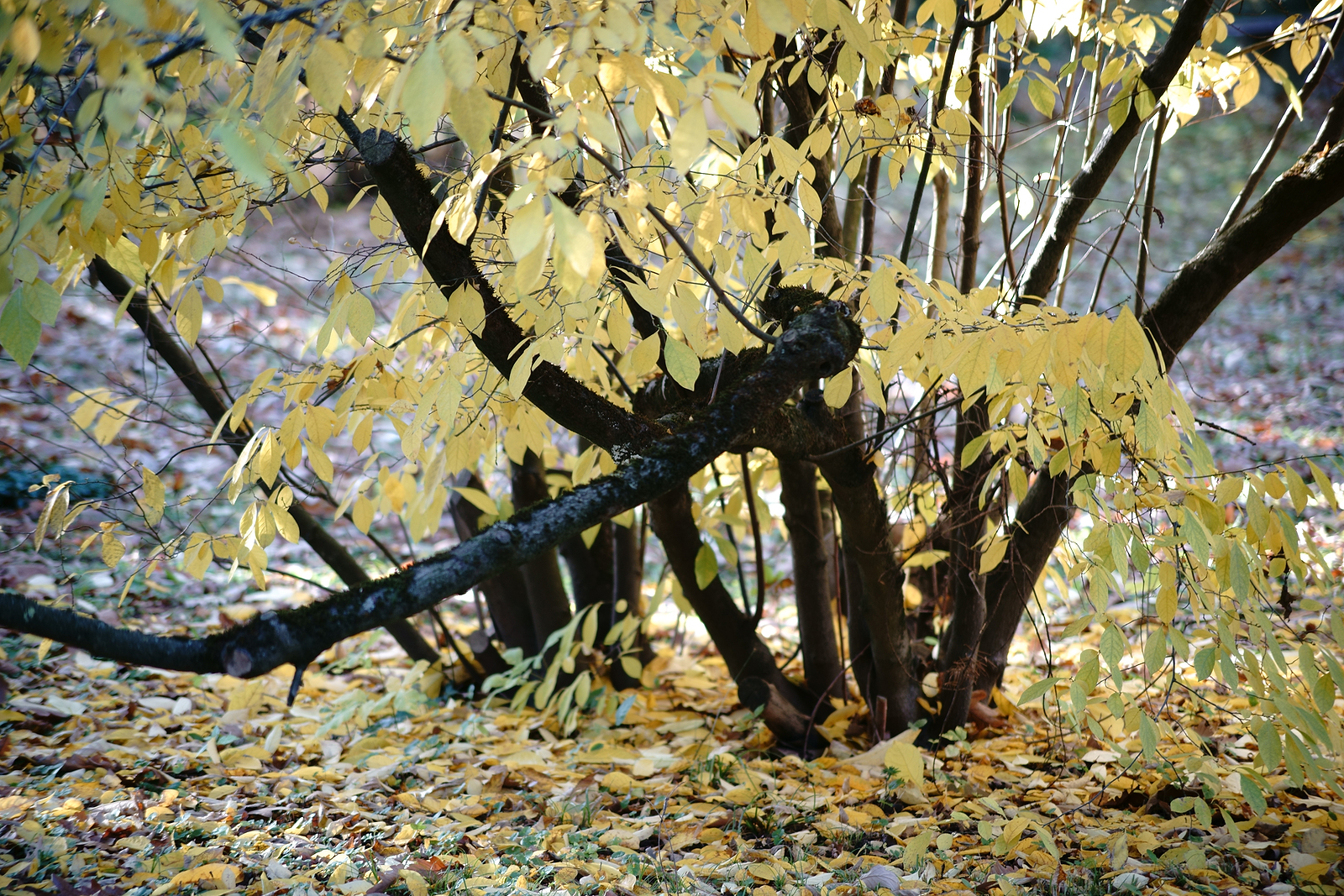 Lindera benzoin (spicebush): A rounded bush, all parts of which are spicy-scented when broken. Leaves are light green, becoming yellow in fall, and the yellow flowers open in spring before the leaves. Fruits appear in summer and last into autumn. A variety of birds eat this fruit, especially thrushes—including robins–wood thrush, and veeries. Grows best in Zones 4-9.
Lindera benzoin (spicebush): A rounded bush, all parts of which are spicy-scented when broken. Leaves are light green, becoming yellow in fall, and the yellow flowers open in spring before the leaves. Fruits appear in summer and last into autumn. A variety of birds eat this fruit, especially thrushes—including robins–wood thrush, and veeries. Grows best in Zones 4-9.
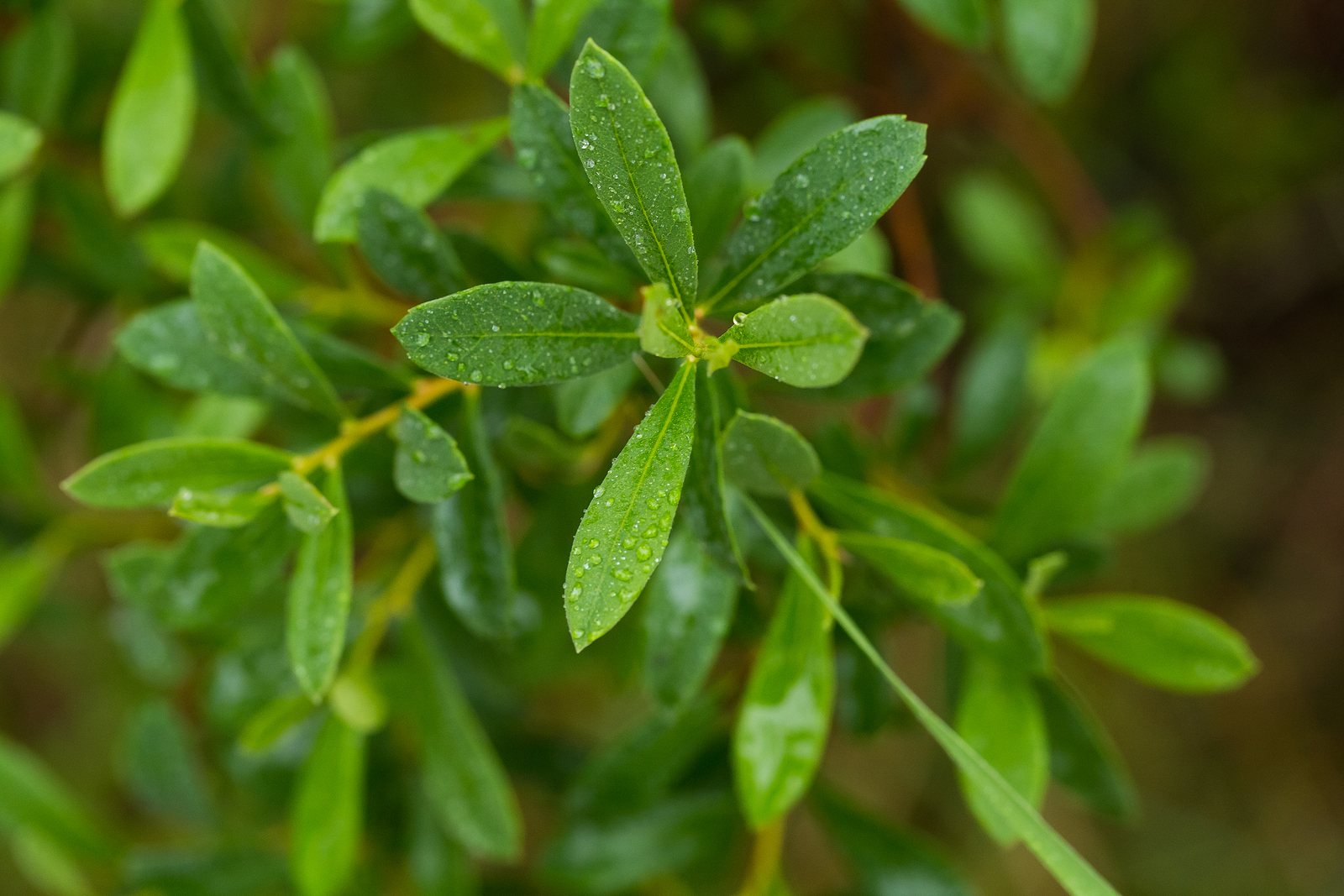 Myrica pensylvanica (barberry): (Myrica pensylvanica) Attractive semi-evergreen shrub with aromatic leaves. Small green flowers are inconspicuous, but female plants produce waxy fruit. The fruit remains on the plant nearly year-round and attracts tree Swallows, catbirds, bluebirds, and many other birds. Grows best in Zones 2-7.
Myrica pensylvanica (barberry): (Myrica pensylvanica) Attractive semi-evergreen shrub with aromatic leaves. Small green flowers are inconspicuous, but female plants produce waxy fruit. The fruit remains on the plant nearly year-round and attracts tree Swallows, catbirds, bluebirds, and many other birds. Grows best in Zones 2-7.
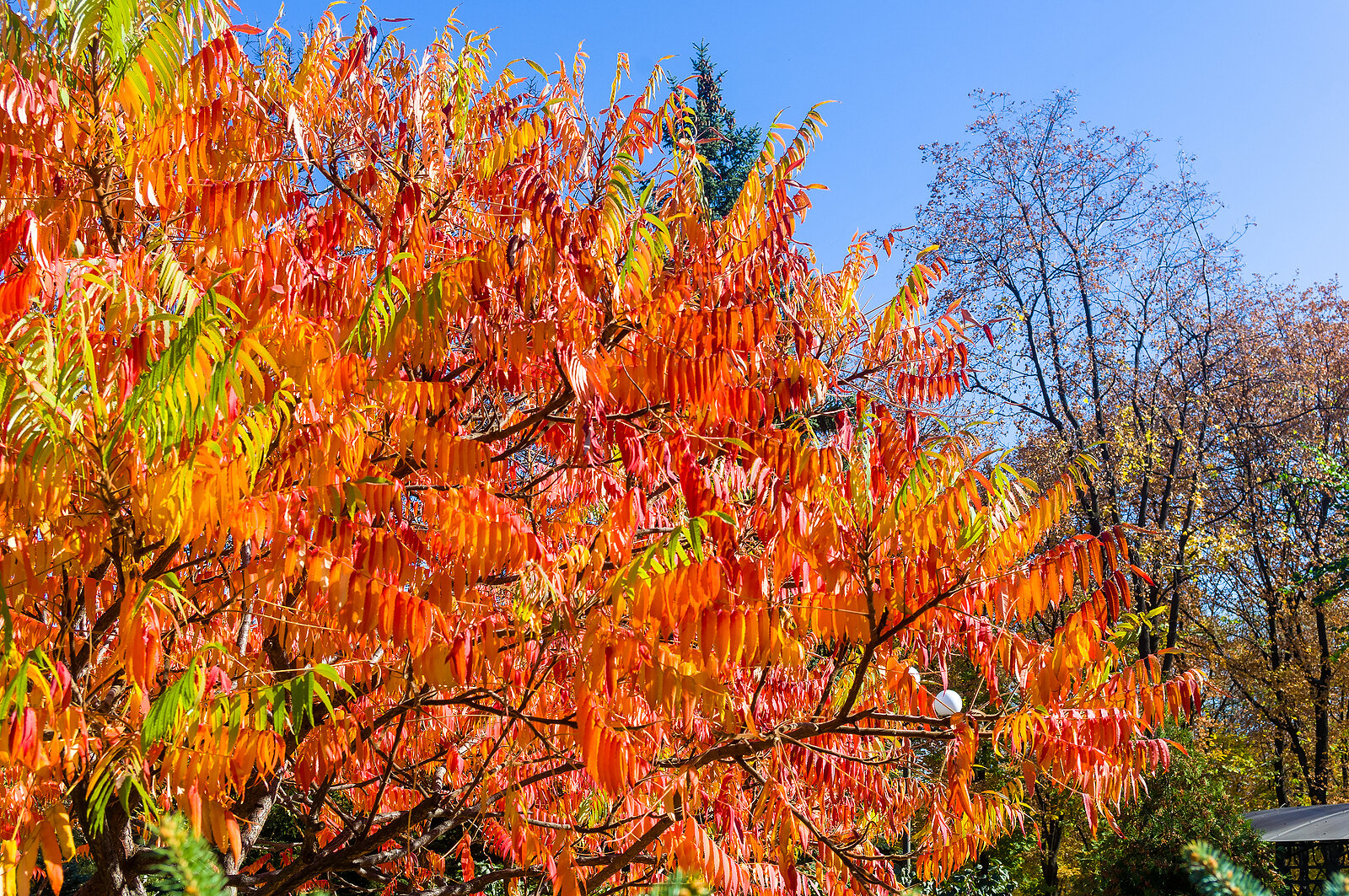 Rhus spp. (sumac): Commonly grown for its leaves that turn fiery red in autumn, sometimes with orange undertones. Flowers are generally greenish yellow followed by brilliant red fruits which appear in clusters. Almost 100 different types of birds, including flickers, towhees, and tanagers find food and shelter in Rhus. Grows best in Zones 3-9.
Rhus spp. (sumac): Commonly grown for its leaves that turn fiery red in autumn, sometimes with orange undertones. Flowers are generally greenish yellow followed by brilliant red fruits which appear in clusters. Almost 100 different types of birds, including flickers, towhees, and tanagers find food and shelter in Rhus. Grows best in Zones 3-9.
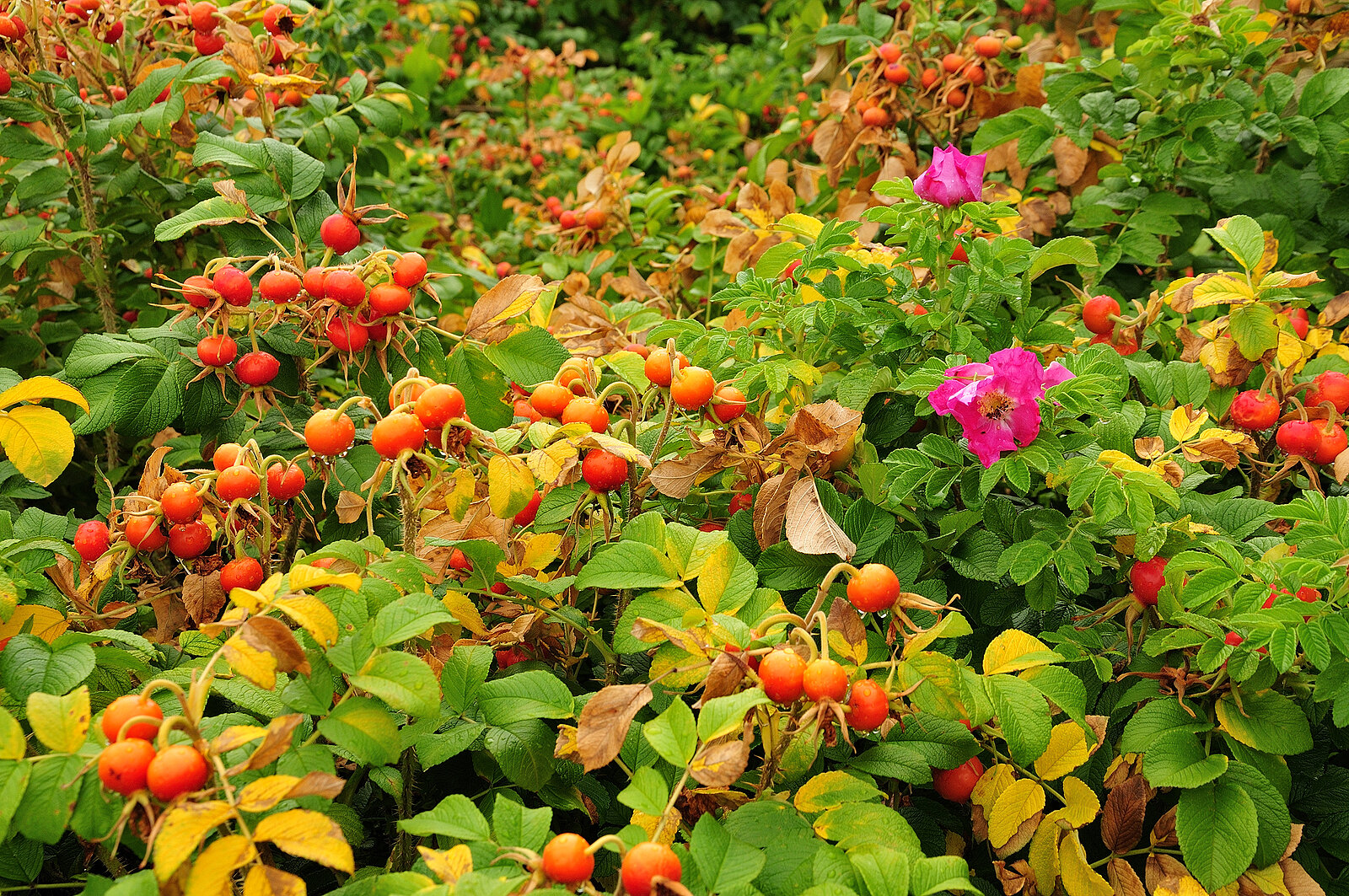 Rosa rugosa (Rugosa rose): Vigorous, dense species rose with very prickly stems and wrinkled, leathery dark green leaves. Cupped single fragrant flowers usually violet-carmine-red. Flower clusters are followed by small tomato-shaped red to orange rose hips. Rose hips are eaten by blackbirds, fieldfares, and mistle thrushes. The smaller hips of the dog rose, Rosa canina, are eaten by a wider range of birds and stay juicy until late winter. Grows best in Zone 4-9.
Rosa rugosa (Rugosa rose): Vigorous, dense species rose with very prickly stems and wrinkled, leathery dark green leaves. Cupped single fragrant flowers usually violet-carmine-red. Flower clusters are followed by small tomato-shaped red to orange rose hips. Rose hips are eaten by blackbirds, fieldfares, and mistle thrushes. The smaller hips of the dog rose, Rosa canina, are eaten by a wider range of birds and stay juicy until late winter. Grows best in Zone 4-9.
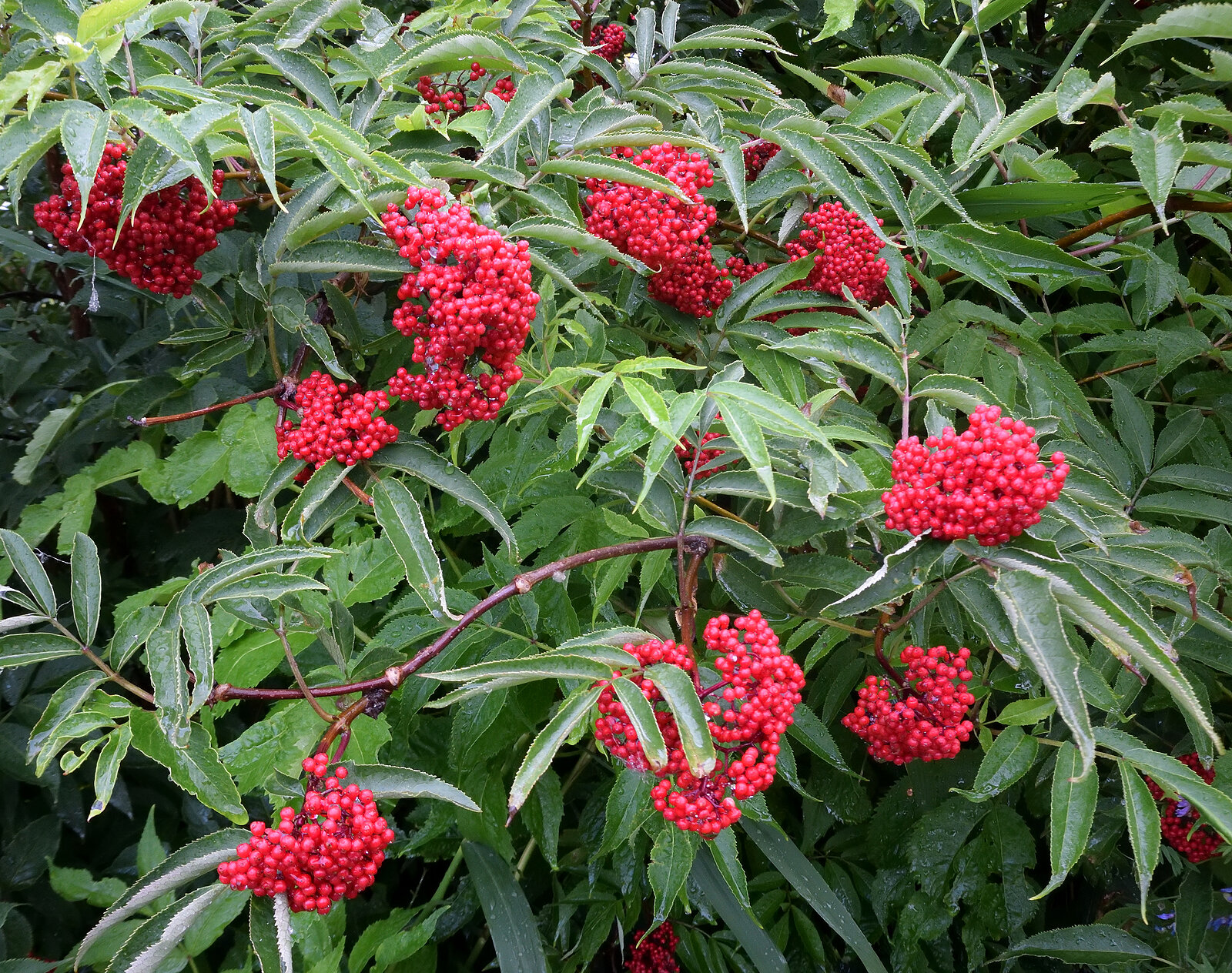 Sambucus canadensis (American elderberry): Large shrub with colorful foliage and moderately showy flowers and fruits. Autumn fruits can be pink, red, or black. Jays, thrashers, finches, warblers, orioles, bluebirds, grosbeaks, mockingbirds, sparrows, vireos, pigeons, bluebirds, magpies, western tanagers, towhees, woodpeckers, grouse, and quail eat the fruits. Grows best in Zones 3-7.
Sambucus canadensis (American elderberry): Large shrub with colorful foliage and moderately showy flowers and fruits. Autumn fruits can be pink, red, or black. Jays, thrashers, finches, warblers, orioles, bluebirds, grosbeaks, mockingbirds, sparrows, vireos, pigeons, bluebirds, magpies, western tanagers, towhees, woodpeckers, grouse, and quail eat the fruits. Grows best in Zones 3-7.
 Symphoricarpos spp. (Snowberry): Vigorously branching shrub that is grown primarily for its clusters of showy, fleshy fruit in fall. Small inconspicuous flowers appear in summer. Fruits can be white, pink, or reddish-purple and last well into winter. Robins, waxwings, and thrushes are known to eat the berries. Grows best in Zones 4-7.
Symphoricarpos spp. (Snowberry): Vigorously branching shrub that is grown primarily for its clusters of showy, fleshy fruit in fall. Small inconspicuous flowers appear in summer. Fruits can be white, pink, or reddish-purple and last well into winter. Robins, waxwings, and thrushes are known to eat the berries. Grows best in Zones 4-7.
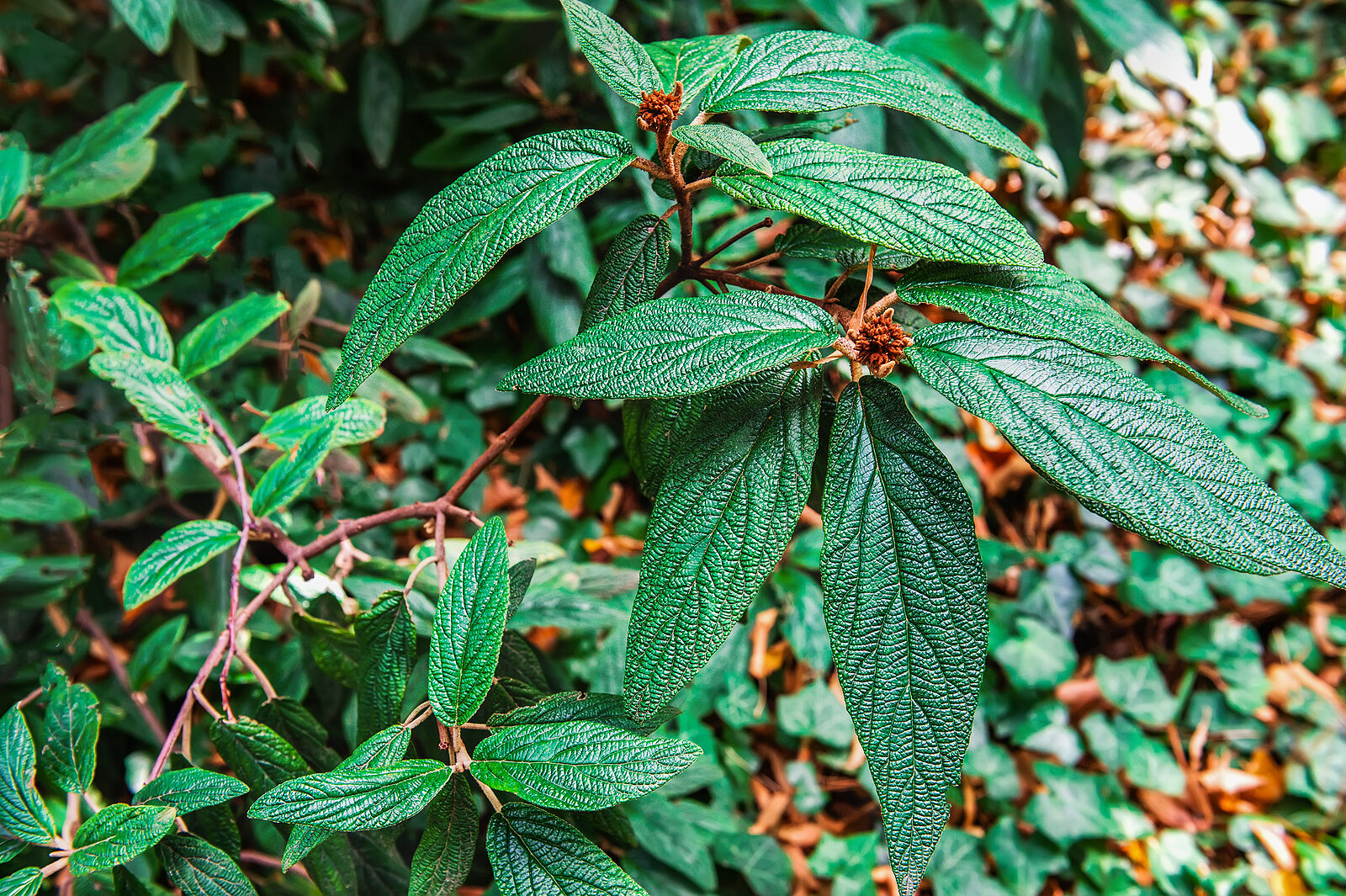 Viburnum dilatatum (linden viburnum), V. opulus (Eastern cranberry bush), V. trilobum (American cranberry bush): Handsome shrubs often with glossy leaves; flowers are usually white and develop in attractive flat or ball-like terminal clusters. Blue-black fruits follow flowers in late summer and autumn and are highly attractive to birds including cardinals, eastern bluebirds, robins, and cedar waxwings. Grows best in Zones 3-8.
Viburnum dilatatum (linden viburnum), V. opulus (Eastern cranberry bush), V. trilobum (American cranberry bush): Handsome shrubs often with glossy leaves; flowers are usually white and develop in attractive flat or ball-like terminal clusters. Blue-black fruits follow flowers in late summer and autumn and are highly attractive to birds including cardinals, eastern bluebirds, robins, and cedar waxwings. Grows best in Zones 3-8.
Trees
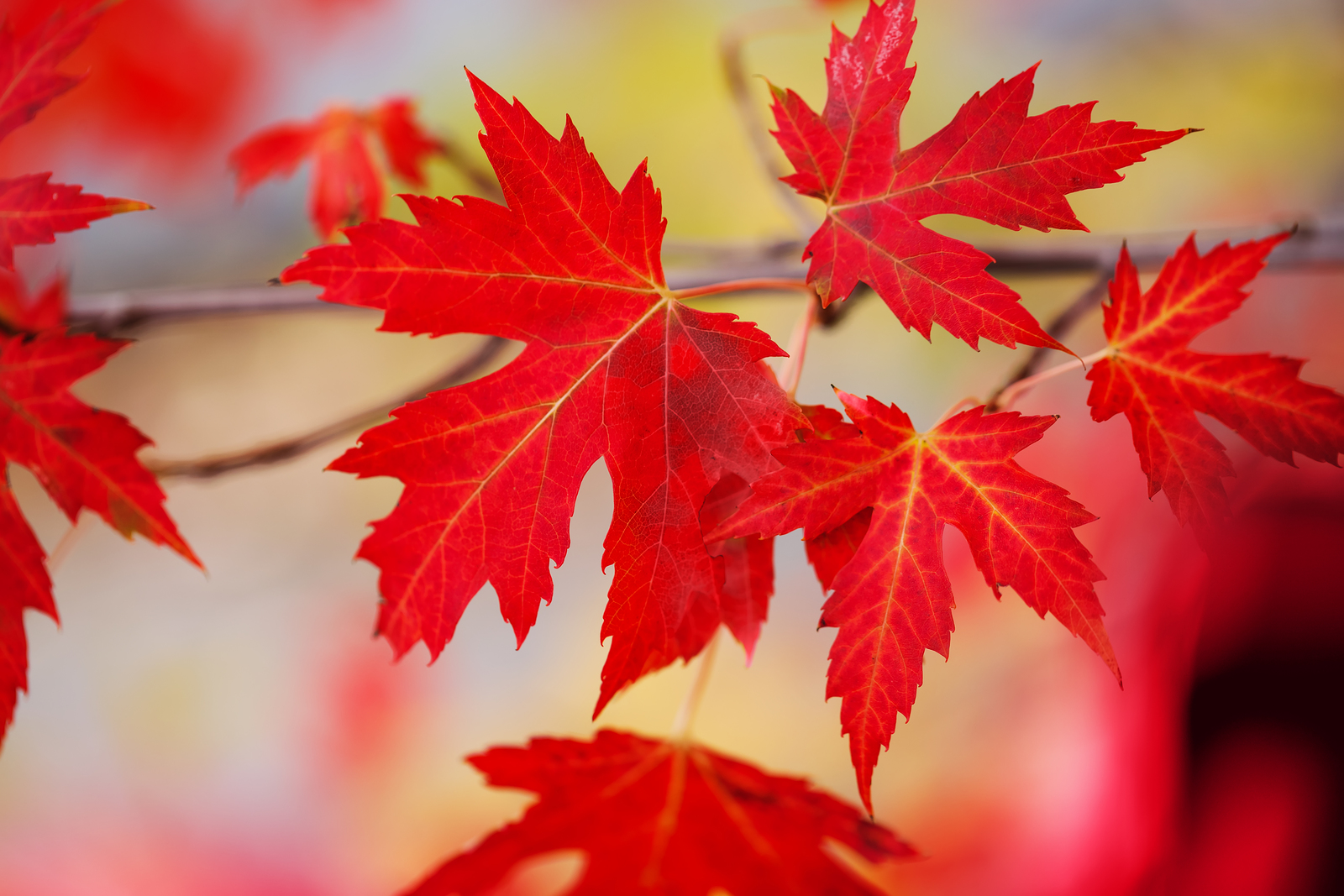 Acer spp. (maple): Acers come in all sizes–large and midsize deciduous shade trees, smaller evergreen and deciduous trees, and small picturesque shrub trees. Nearly all are remarkable for their autumn foliage colors–yellows, oranges, to reds. Winged fruits appear on nearly all; the seeds are favorites of finches, juncos, and nuthatches. Most maples will grow comfortably in Zones 3-8, some in warmer regions.
Acer spp. (maple): Acers come in all sizes–large and midsize deciduous shade trees, smaller evergreen and deciduous trees, and small picturesque shrub trees. Nearly all are remarkable for their autumn foliage colors–yellows, oranges, to reds. Winged fruits appear on nearly all; the seeds are favorites of finches, juncos, and nuthatches. Most maples will grow comfortably in Zones 3-8, some in warmer regions.
 Amelanchier spp. (serviceberry): Mid-size deciduous tree to 35 feet (11m) tall produces white flowers in spring; foliage turns yellow to red in autumn. Amelanchier bears deep red berries in the summer, which turn a dark purple shade in the autumn. Amelanchier attracts waxwings, tanagers, robins, blackbirds, and cardinals. Grows best in Zones 4-9.
Amelanchier spp. (serviceberry): Mid-size deciduous tree to 35 feet (11m) tall produces white flowers in spring; foliage turns yellow to red in autumn. Amelanchier bears deep red berries in the summer, which turn a dark purple shade in the autumn. Amelanchier attracts waxwings, tanagers, robins, blackbirds, and cardinals. Grows best in Zones 4-9.
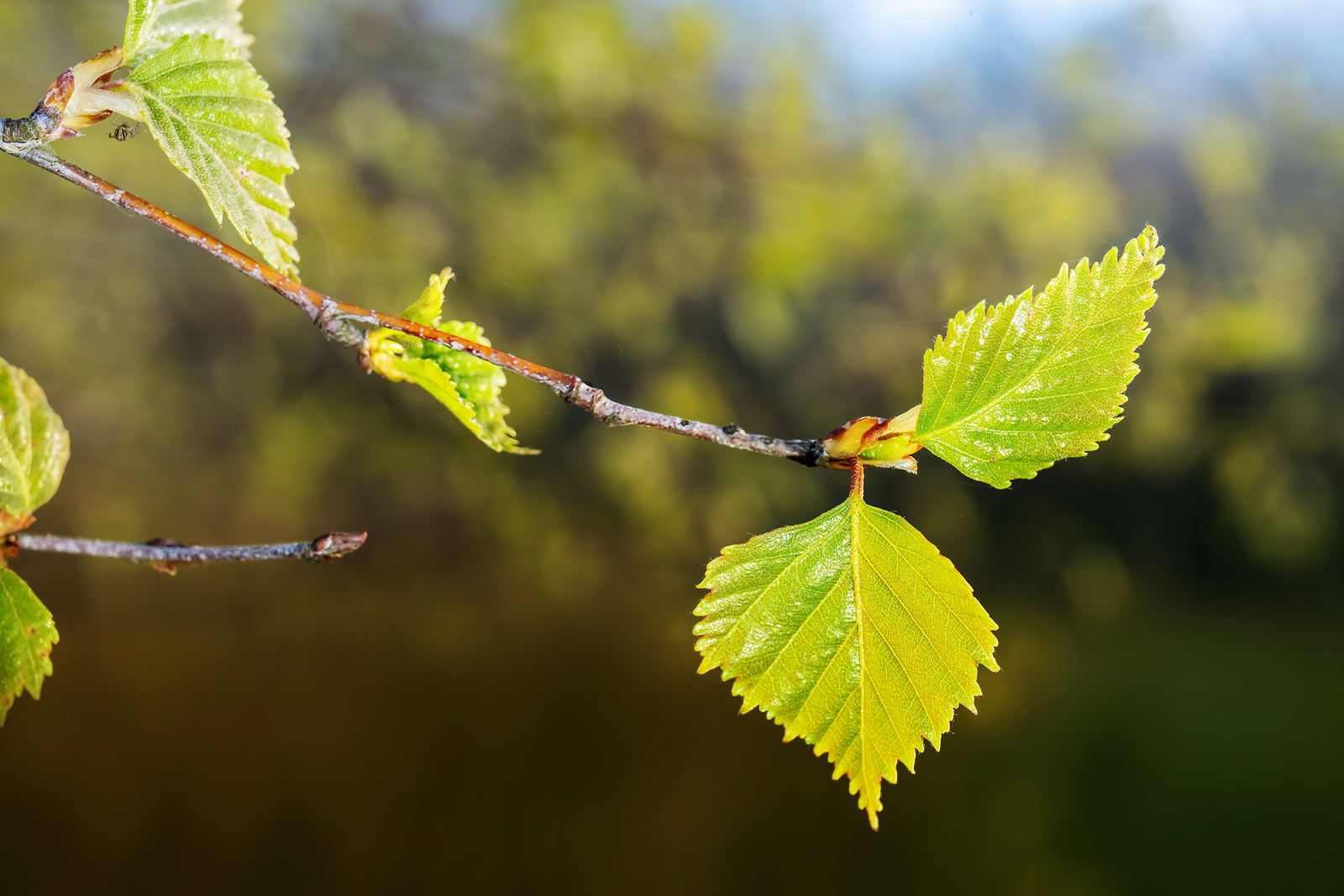 Betula spp. (birch): Tall graceful deciduous trees with finely toothed leaves and white peeling bark; some grow to 60 feet (18m) tall. Drooping catkins in spring. Leaves turn from green to glowing yellow in fall. The goldfinch diet consists almost entirely of birch seeds. Grows best in Zones 3-9.
Betula spp. (birch): Tall graceful deciduous trees with finely toothed leaves and white peeling bark; some grow to 60 feet (18m) tall. Drooping catkins in spring. Leaves turn from green to glowing yellow in fall. The goldfinch diet consists almost entirely of birch seeds. Grows best in Zones 3-9.
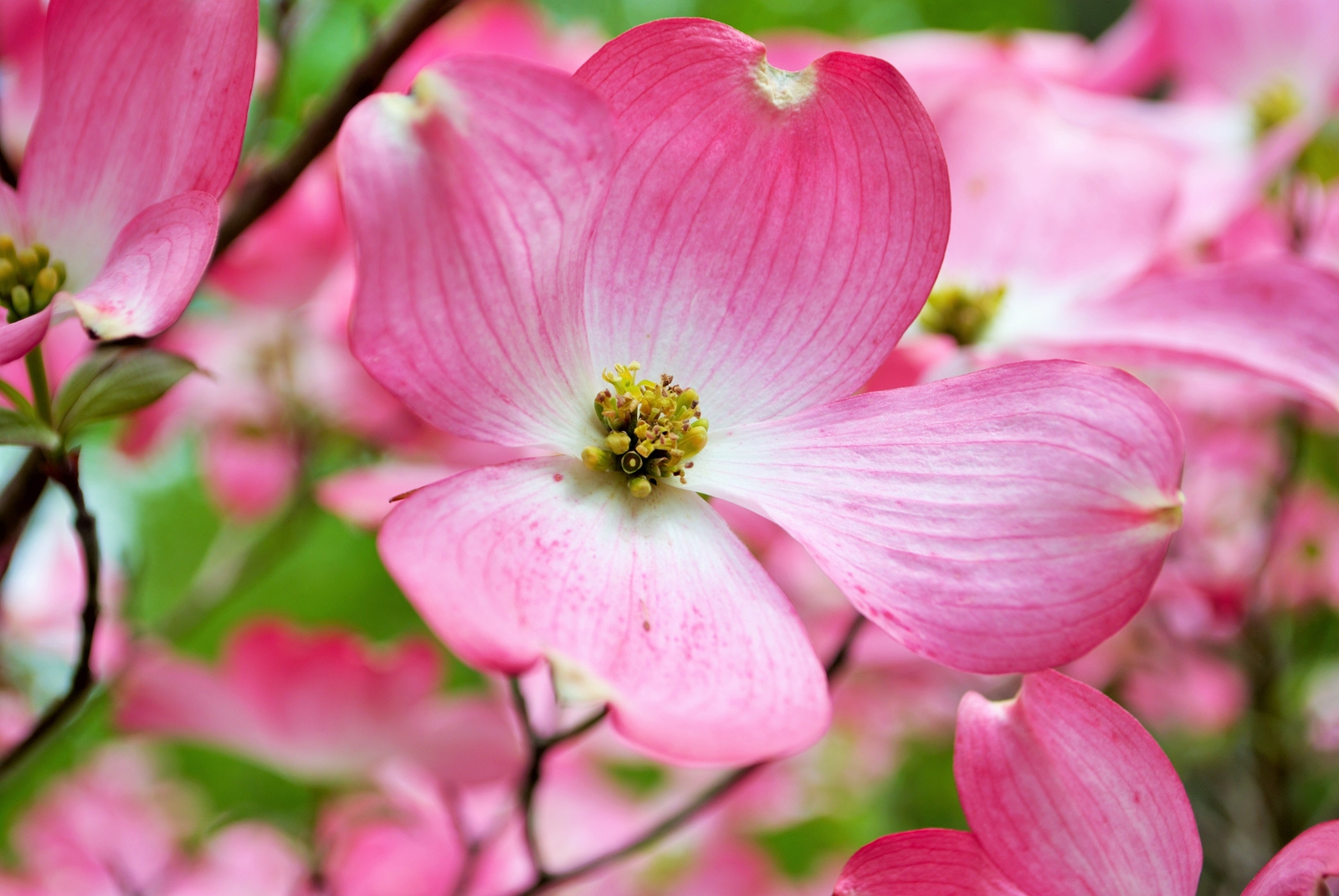 Cornus spp. (dogwood): Small to mid-size tree grows to about 30 feet (10m) tall. Clusters of mostly white flowers held above the branches in spring. Good fall color. Blue black and sometimes scarlet fruits attract birds including robins, hummingbirds, and a number of other insectivorous birds. Grows best in Zones 4-9.
Cornus spp. (dogwood): Small to mid-size tree grows to about 30 feet (10m) tall. Clusters of mostly white flowers held above the branches in spring. Good fall color. Blue black and sometimes scarlet fruits attract birds including robins, hummingbirds, and a number of other insectivorous birds. Grows best in Zones 4-9.
 Crataegus spp. (hawthorn): Small deciduous trees grow to about 25 feet (8m) tall; known for pretty flower clusters after leaf out in spring and for showy fruit resembling tiny apples in summer and fall. Typically multitrunked. The shiny clusters of haws are favorites of blackbirds, redwings, and fieldfares as well as many other species including chaffinches, starlings, and greenfinches. Grow best in Zones 5-7.
Crataegus spp. (hawthorn): Small deciduous trees grow to about 25 feet (8m) tall; known for pretty flower clusters after leaf out in spring and for showy fruit resembling tiny apples in summer and fall. Typically multitrunked. The shiny clusters of haws are favorites of blackbirds, redwings, and fieldfares as well as many other species including chaffinches, starlings, and greenfinches. Grow best in Zones 5-7.
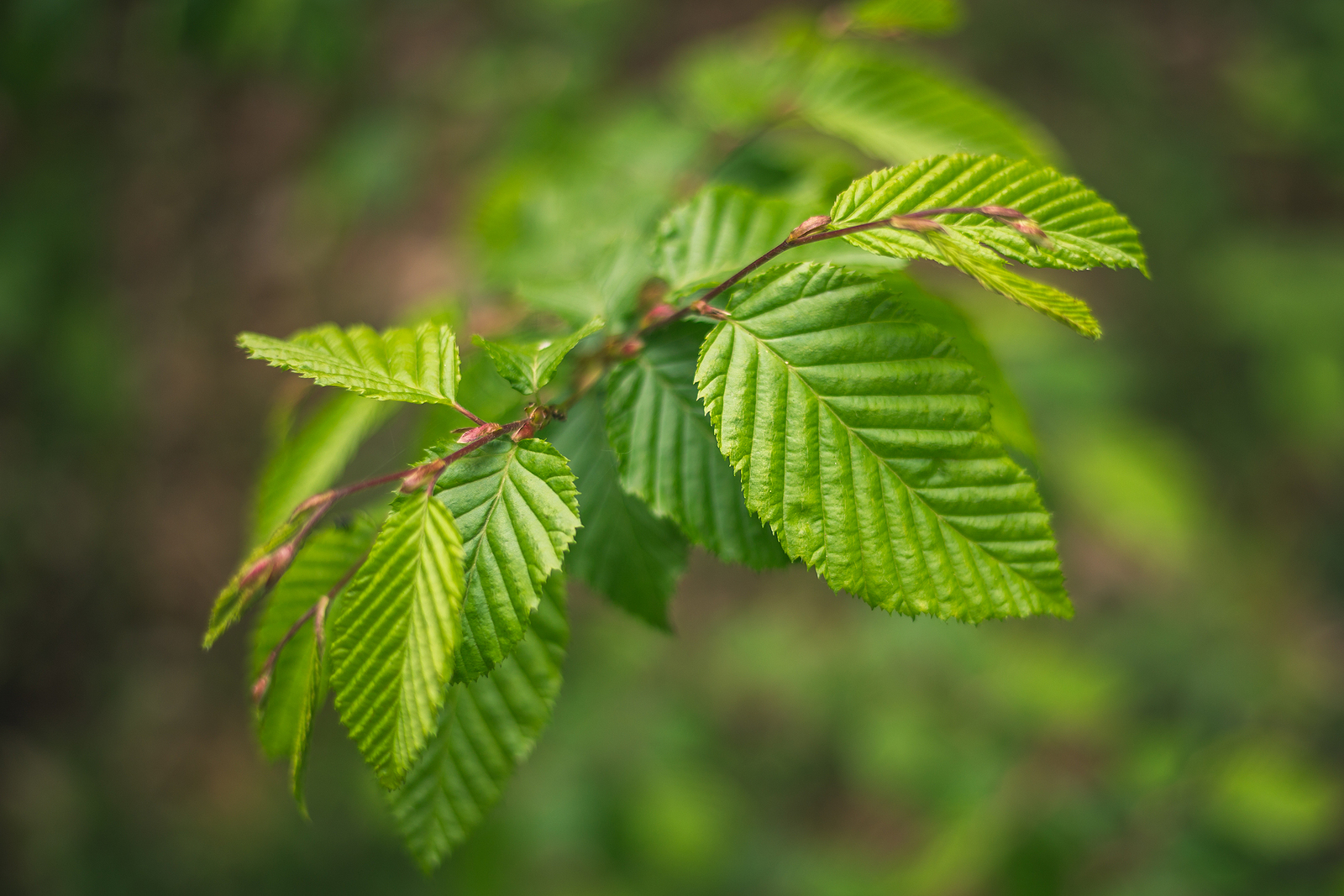 Fagus grandifolia (American beech): A stately tree with attractive light gray bark and foliage that turns yellow-bronze in fall. Grows to 70 feet (20m) tall and half as wide. Small nuts in spiny hulls–beech nuts–are in the diet of blue jays, white-breasted nuthatches, and various woodpeckers, as well as ruffed grouse, turkeys, and wood ducks. Grows best in Zones 3-9.
Fagus grandifolia (American beech): A stately tree with attractive light gray bark and foliage that turns yellow-bronze in fall. Grows to 70 feet (20m) tall and half as wide. Small nuts in spiny hulls–beech nuts–are in the diet of blue jays, white-breasted nuthatches, and various woodpeckers, as well as ruffed grouse, turkeys, and wood ducks. Grows best in Zones 3-9.
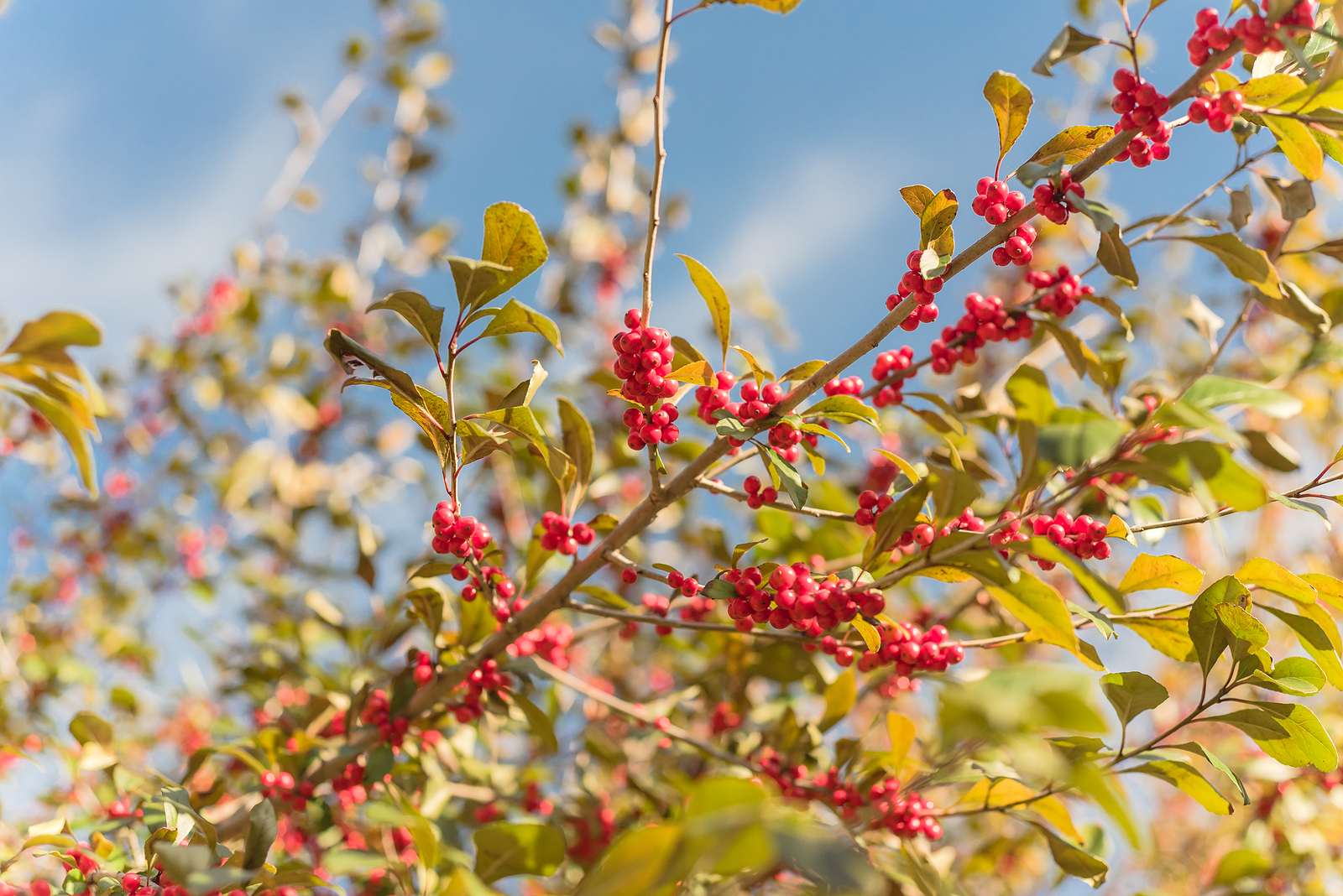 Ilex spp. (holly): Evergreens as wells as deciduous species grown for their foliage and fruit; deciduous types bear showy autumn and winter berries. All Ilex plants are either male or female and as a rule, both sexes must be present for the female to set fruit. Ilex berries attract thrushes, mockingbirds, catbirds, bluebirds, and thrashers. Grows best in Zones 5-9.
Ilex spp. (holly): Evergreens as wells as deciduous species grown for their foliage and fruit; deciduous types bear showy autumn and winter berries. All Ilex plants are either male or female and as a rule, both sexes must be present for the female to set fruit. Ilex berries attract thrushes, mockingbirds, catbirds, bluebirds, and thrashers. Grows best in Zones 5-9.
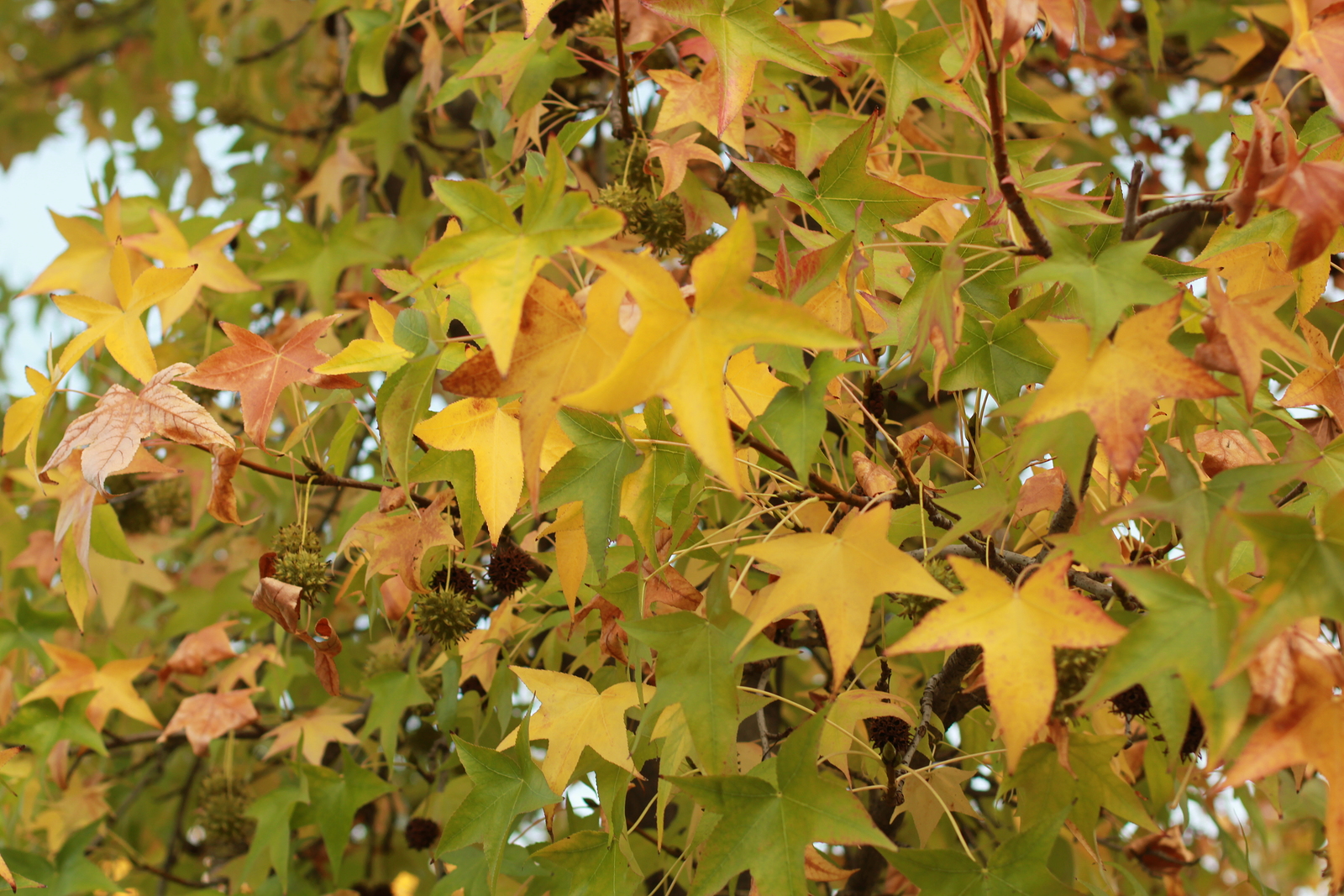 Liquidambar styraciflua (sweet gum): Narrow and erect deciduous tree grows to 70 feet (20m). Leaves are star-shaped. A sweet-smelling gum excudes from the crevices in the trunk. Outstanding fall colors of yellow, red, and bronze. The tree’s trunk, with deeply creviced bark where many insects hide, makes it a favorite of insect-eating woodpeckers, nuthatches, brown creepers, and Carolina wrens, as well northern bobwhites, mourning doves, northern cardinals, Carolina chickadees, and pine siskins. Grows best in Zones 5-9.
Liquidambar styraciflua (sweet gum): Narrow and erect deciduous tree grows to 70 feet (20m). Leaves are star-shaped. A sweet-smelling gum excudes from the crevices in the trunk. Outstanding fall colors of yellow, red, and bronze. The tree’s trunk, with deeply creviced bark where many insects hide, makes it a favorite of insect-eating woodpeckers, nuthatches, brown creepers, and Carolina wrens, as well northern bobwhites, mourning doves, northern cardinals, Carolina chickadees, and pine siskins. Grows best in Zones 5-9.
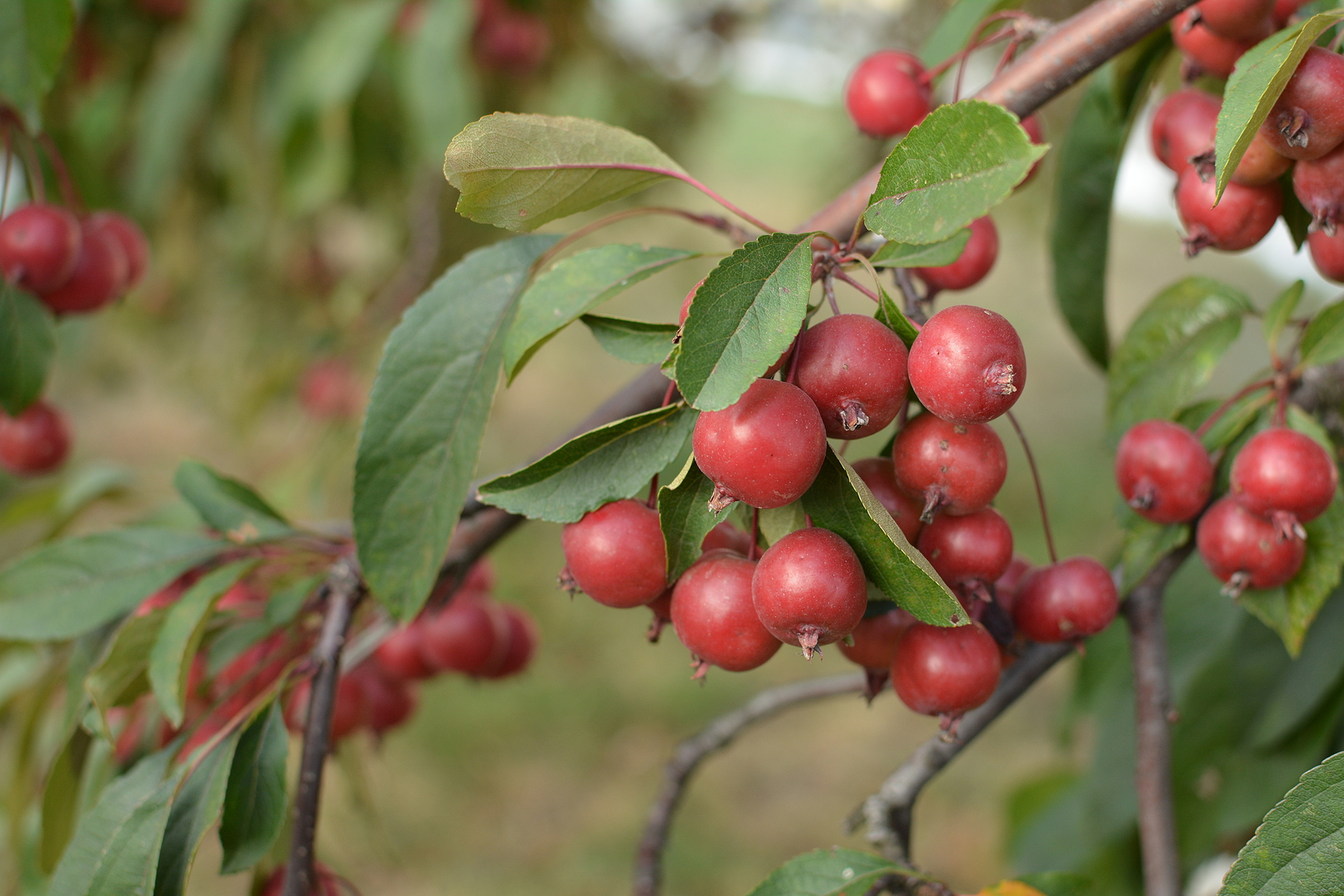 Malus spp. (crabapple): Small deciduous tree with masses of single, semi-double, or double white or pink, flowers in spring followed by tiny red, yellow, or orange apples. Grows to about 25 feet (8m) tall. Fruits hang on the tree through winter and are an excellent source of food for birds in the winter. Cardinals, cedar waxwings, and robins are especially drawn to crabapples. Grows best in Zones 4-8.
Malus spp. (crabapple): Small deciduous tree with masses of single, semi-double, or double white or pink, flowers in spring followed by tiny red, yellow, or orange apples. Grows to about 25 feet (8m) tall. Fruits hang on the tree through winter and are an excellent source of food for birds in the winter. Cardinals, cedar waxwings, and robins are especially drawn to crabapples. Grows best in Zones 4-8.
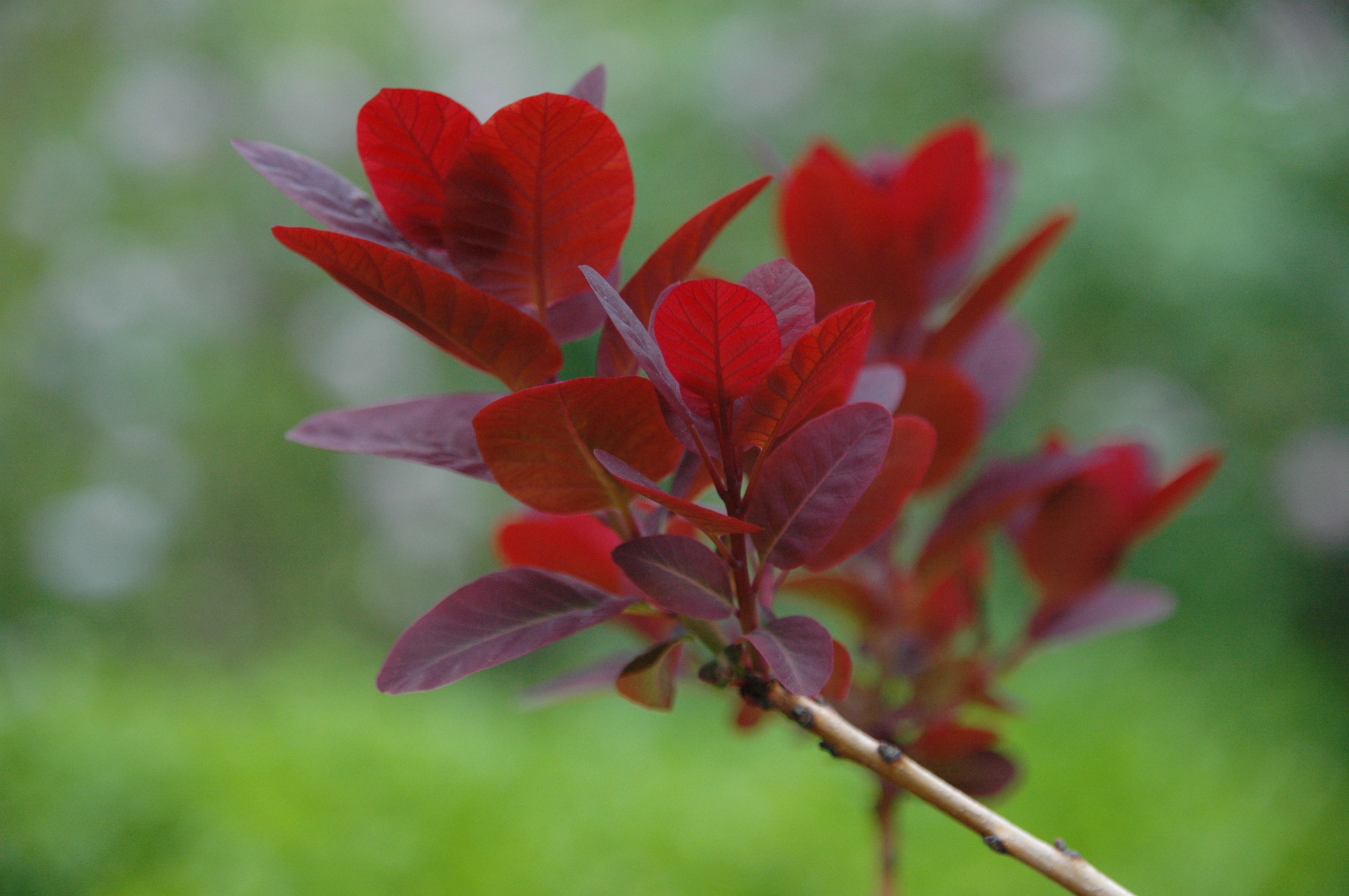 Nyssa sylvatica (black gum): Pyramidal tree when young become spreading with age growing to as tall as 50 feet (15). Leaves turn yellow and orange, then bright red before fall in autumn. Silhouette and dark bark are dramatic in winter. Fruits are bluish-black, shaped like small olives. The fruits are eaten by ruffed grouse, bobwhite quail, wild turkeys, wood ducks, and more than 30 species of songbirds. Grows best in Zones 4-9.
Nyssa sylvatica (black gum): Pyramidal tree when young become spreading with age growing to as tall as 50 feet (15). Leaves turn yellow and orange, then bright red before fall in autumn. Silhouette and dark bark are dramatic in winter. Fruits are bluish-black, shaped like small olives. The fruits are eaten by ruffed grouse, bobwhite quail, wild turkeys, wood ducks, and more than 30 species of songbirds. Grows best in Zones 4-9.
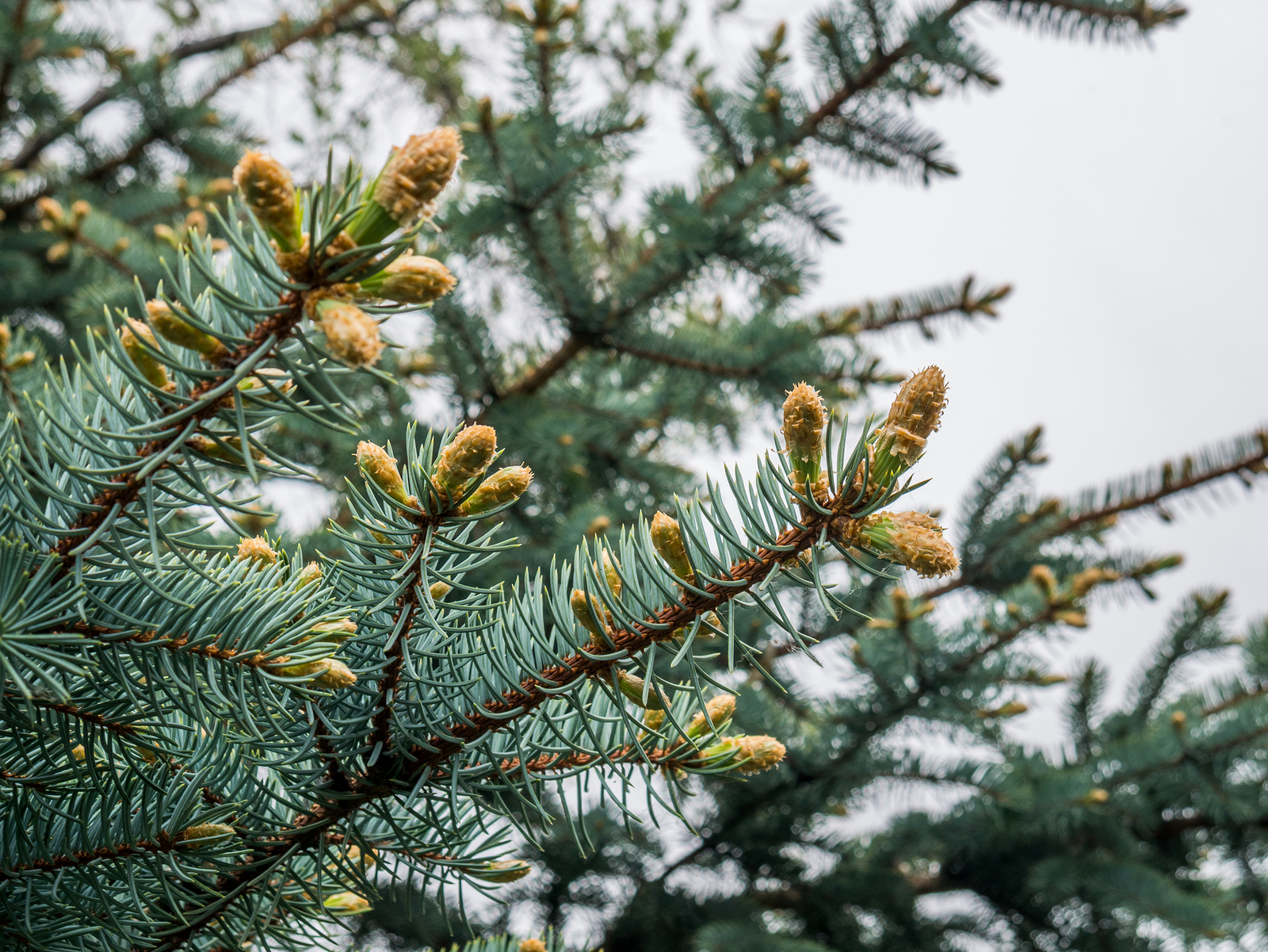 Picea spp. (spruce): Pyramidal coniferous evergreen tree to 70 feet (20m) tall has stiff needles with branches arranged in neat tiers. The seed-filled cones attract nuthatches, finches, grosbeaks, chickadees, and other seed-eating birds. Several species are suited for gardens. Grows best in Zones 4-7.
Picea spp. (spruce): Pyramidal coniferous evergreen tree to 70 feet (20m) tall has stiff needles with branches arranged in neat tiers. The seed-filled cones attract nuthatches, finches, grosbeaks, chickadees, and other seed-eating birds. Several species are suited for gardens. Grows best in Zones 4-7.
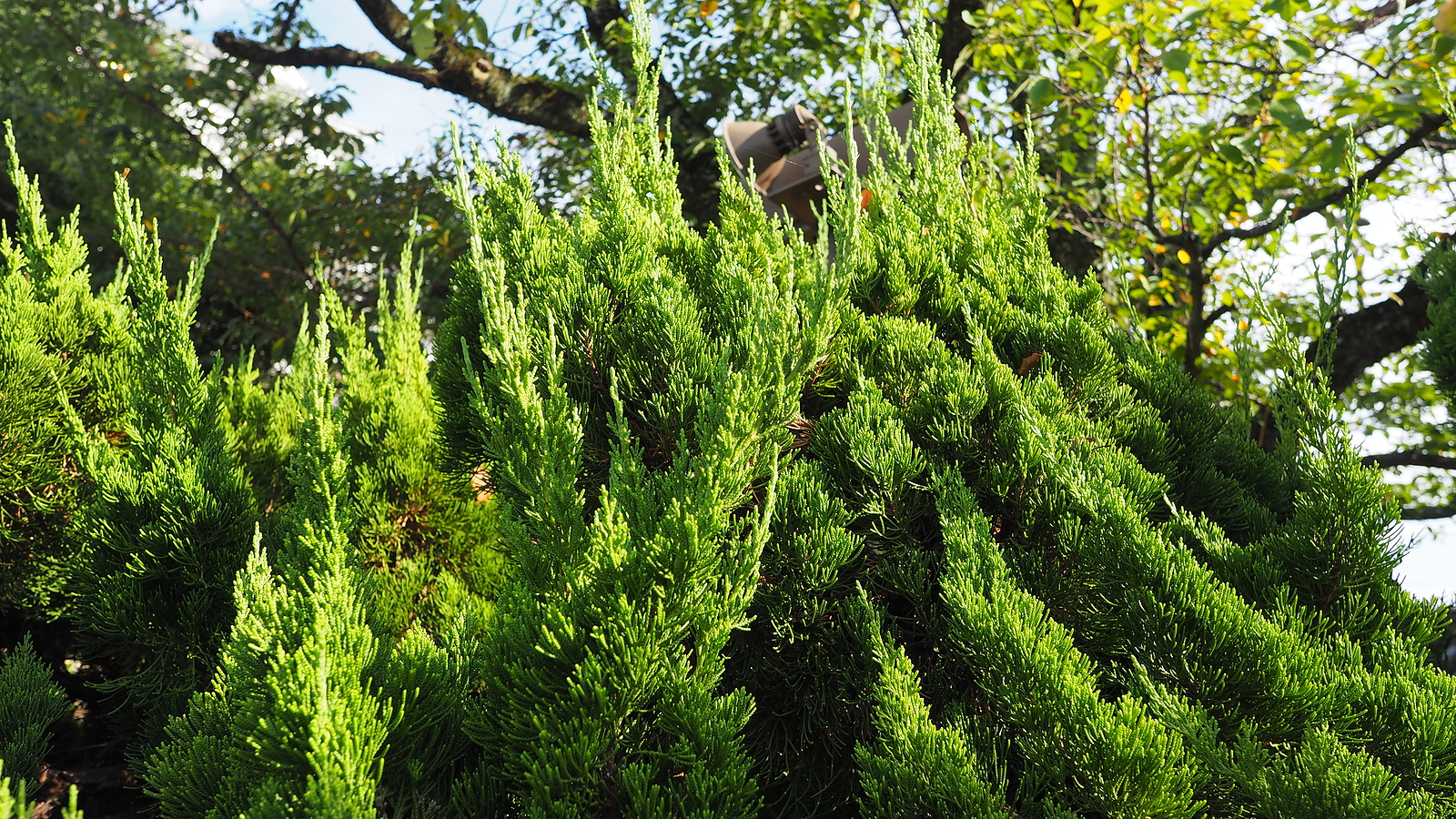 Pinus spp. (pine): Coniferous evergreen tend to be pyramidal in youth and more open or round-topped with age. Numerous species each differing in how they respond to wind, heat, and other growing conditions. Seed-filled cones seed-filled cones attract nuthatches, finches, grosbeaks, and chickadees. Growing zones vary, generally best in Zones 4-7.
Pinus spp. (pine): Coniferous evergreen tend to be pyramidal in youth and more open or round-topped with age. Numerous species each differing in how they respond to wind, heat, and other growing conditions. Seed-filled cones seed-filled cones attract nuthatches, finches, grosbeaks, and chickadees. Growing zones vary, generally best in Zones 4-7.
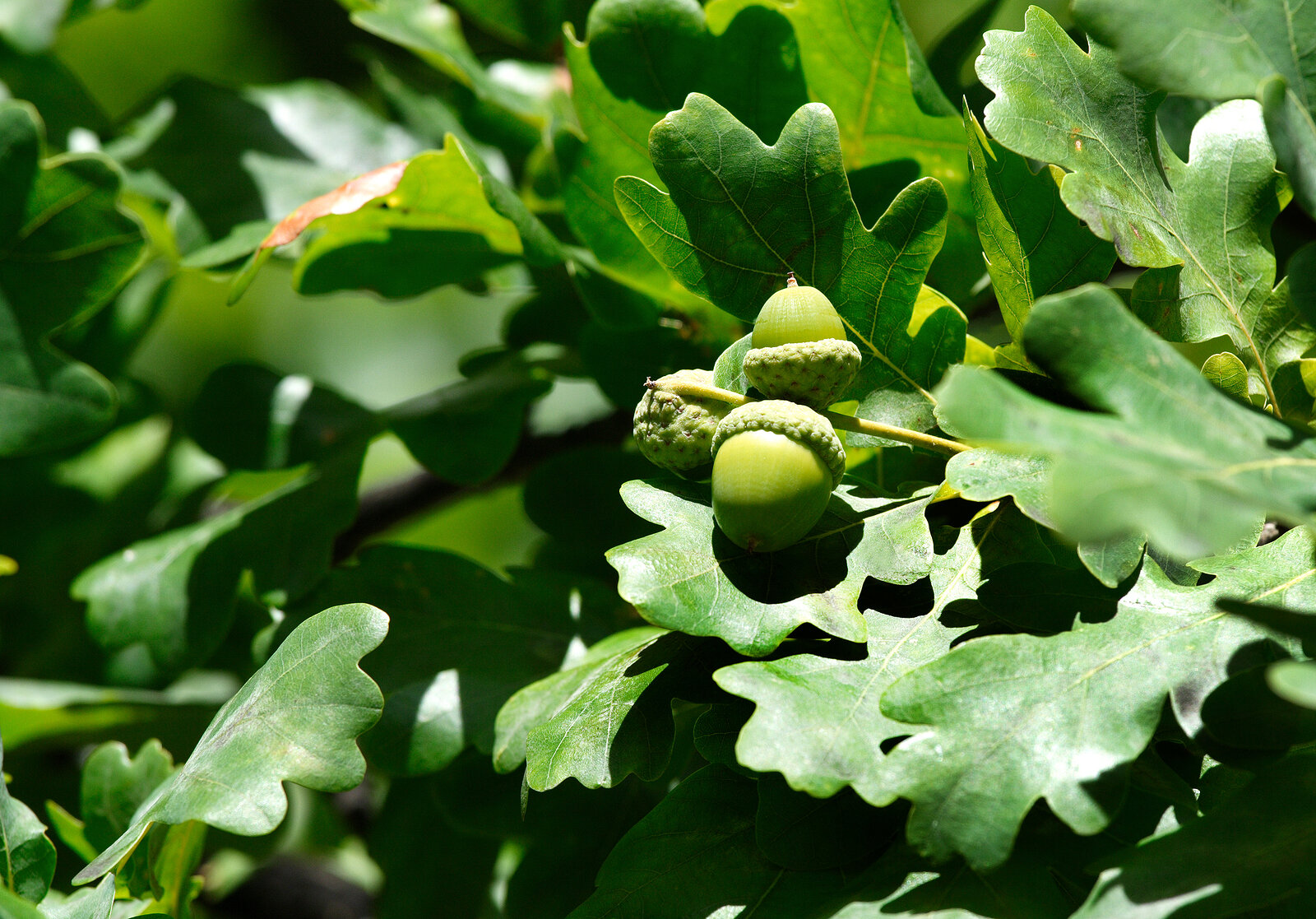 Quercus spp. (oak): More than 600 species of deciduous and evergreen trees growing from 30 to 60 feet (10-18m) tall, all with a common feature–the production of acorns, single nuts. Orioles, woodpeckers, thrashers, flickers, grosbeaks, hummingbirds, tanagers, titmouse birds, warblers, nuthatches, and all insectivorous birds are attracted to oaks. All grow in Zones 4-8; some grow in cold or warmer zones.
Quercus spp. (oak): More than 600 species of deciduous and evergreen trees growing from 30 to 60 feet (10-18m) tall, all with a common feature–the production of acorns, single nuts. Orioles, woodpeckers, thrashers, flickers, grosbeaks, hummingbirds, tanagers, titmouse birds, warblers, nuthatches, and all insectivorous birds are attracted to oaks. All grow in Zones 4-8; some grow in cold or warmer zones.
 Sorbus spp. (mountain ash): Mid-size deciduous trees are valued for showy flowers and shower fruit. Grows to 30 feet (10m) tall; fernlike leaves turn orange to scarlet in autumn. Vivid clusters of bright red, autumn berries are a favorite food of waxwings, redwings, and other thrushes. Grows best in Zones 3-7.
Sorbus spp. (mountain ash): Mid-size deciduous trees are valued for showy flowers and shower fruit. Grows to 30 feet (10m) tall; fernlike leaves turn orange to scarlet in autumn. Vivid clusters of bright red, autumn berries are a favorite food of waxwings, redwings, and other thrushes. Grows best in Zones 3-7.
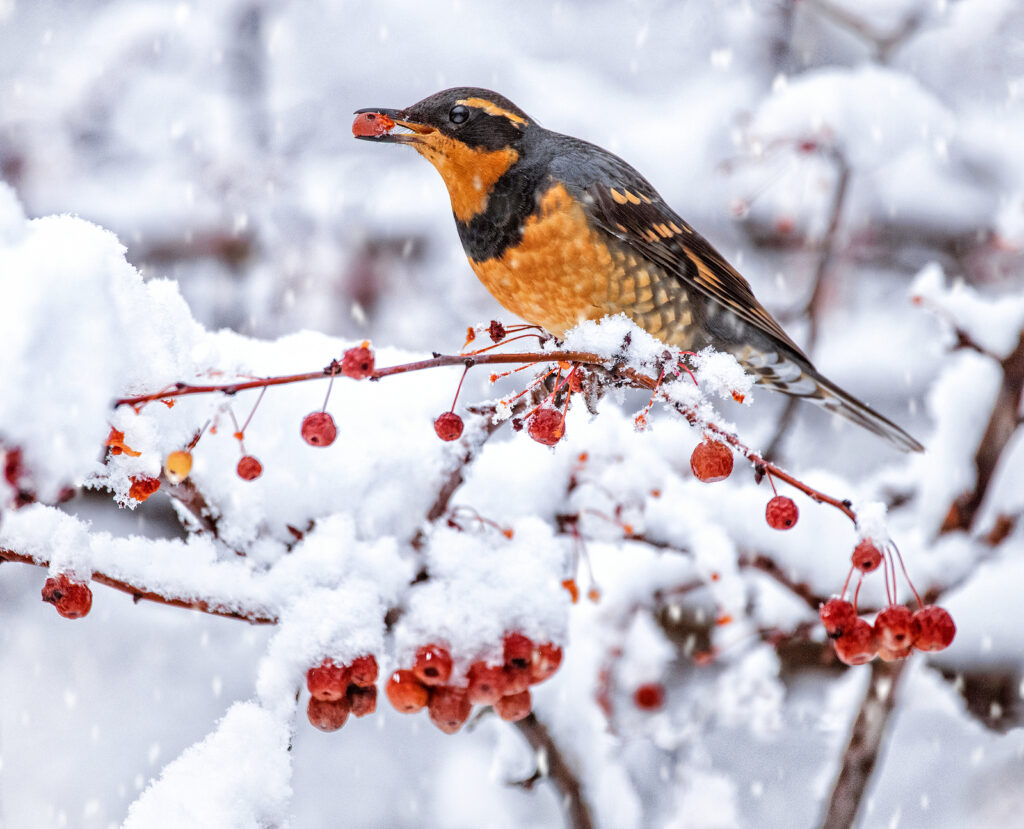
Vines and Groundcovers
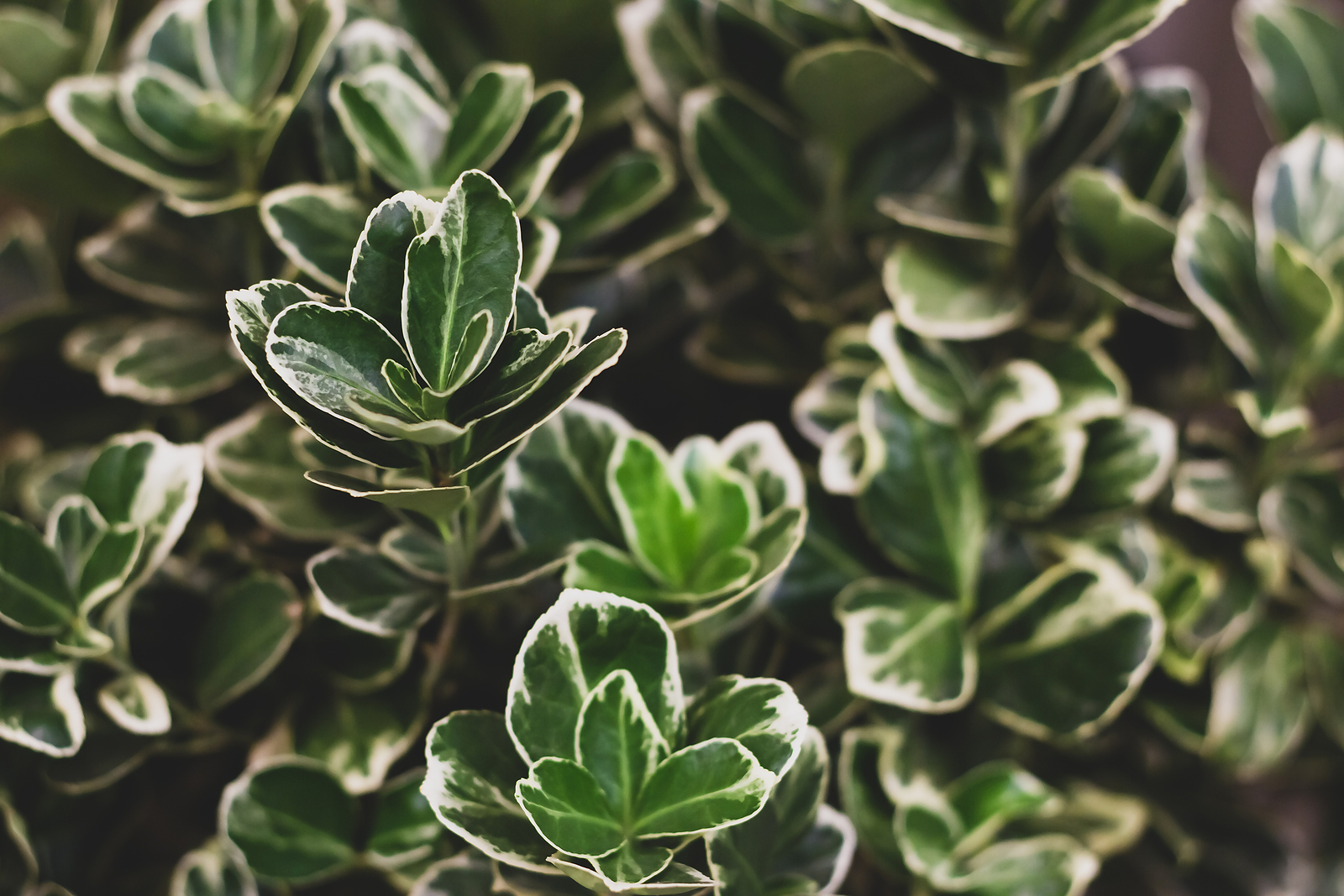 Euonymus fortunei (wintercreeper): Evergreen shrub with prostrate forms. Tiny flowers in late spring are inconspicuous but fruit and autumn leaf coloration can be spectacular. Fruits appear in midsummer and last until frost. Fruits attract thrashers, western bluebirds, American robins, northern flickers, Nuttall’s woodpeckers, northern mockingbirds, California scrub jays, and wrentits. Grows best in Zones 4-8.
Euonymus fortunei (wintercreeper): Evergreen shrub with prostrate forms. Tiny flowers in late spring are inconspicuous but fruit and autumn leaf coloration can be spectacular. Fruits appear in midsummer and last until frost. Fruits attract thrashers, western bluebirds, American robins, northern flickers, Nuttall’s woodpeckers, northern mockingbirds, California scrub jays, and wrentits. Grows best in Zones 4-8.
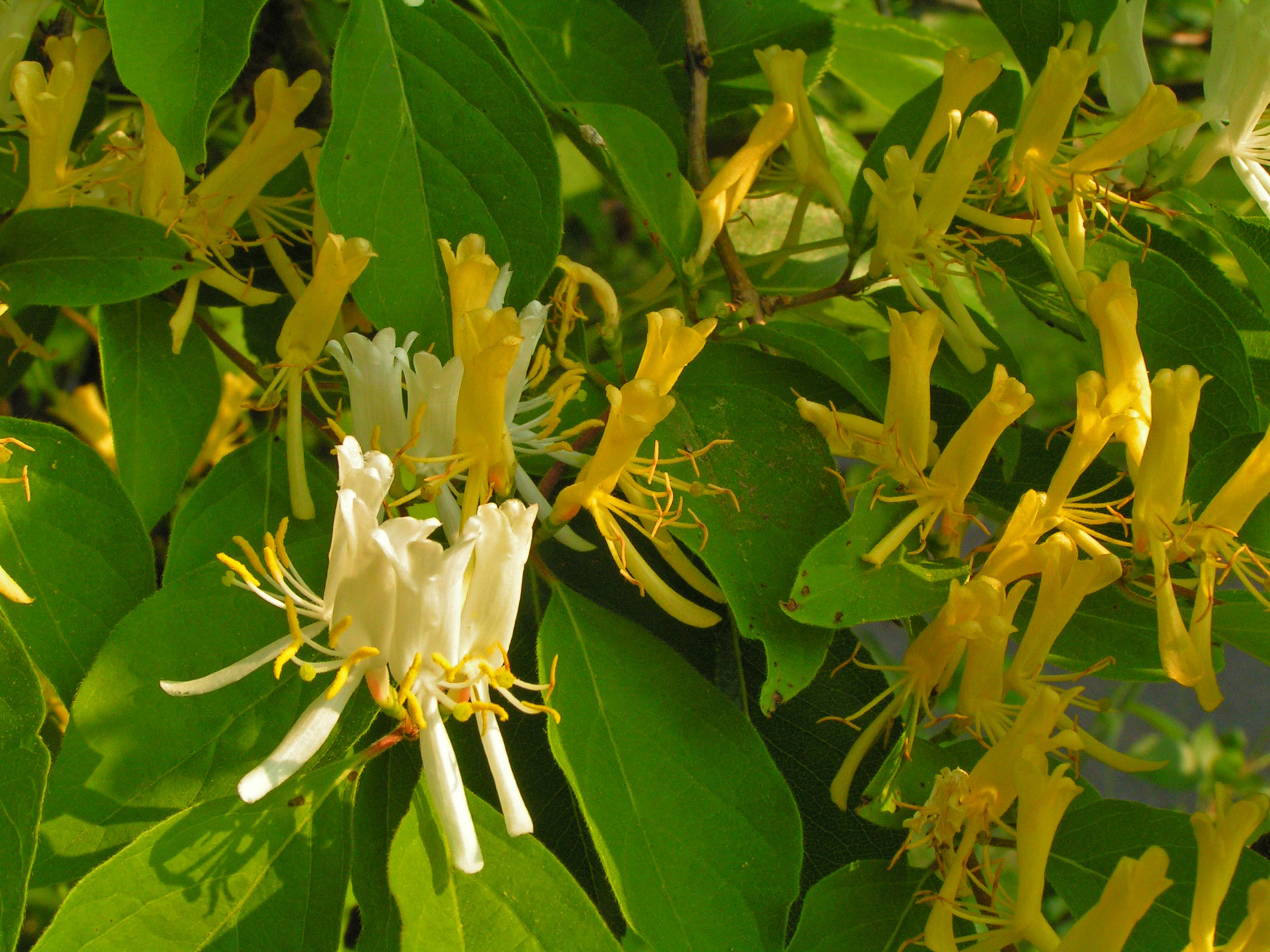 Lonicera spp. (honeysuckle): Evergreen to deciduous vines and shrubs most with tubular, often fragrant white, pink, red, or yellow flowers. Fleshy berries in white, red, yellow, blue, or black. Nectar attracts hummingbirds while many birds like purple finches and hermit thrushes eat their fruit. During migration, Baltimore orioles get to the nectar by eating the flowers. Best in Zones 4-9.
Lonicera spp. (honeysuckle): Evergreen to deciduous vines and shrubs most with tubular, often fragrant white, pink, red, or yellow flowers. Fleshy berries in white, red, yellow, blue, or black. Nectar attracts hummingbirds while many birds like purple finches and hermit thrushes eat their fruit. During migration, Baltimore orioles get to the nectar by eating the flowers. Best in Zones 4-9.
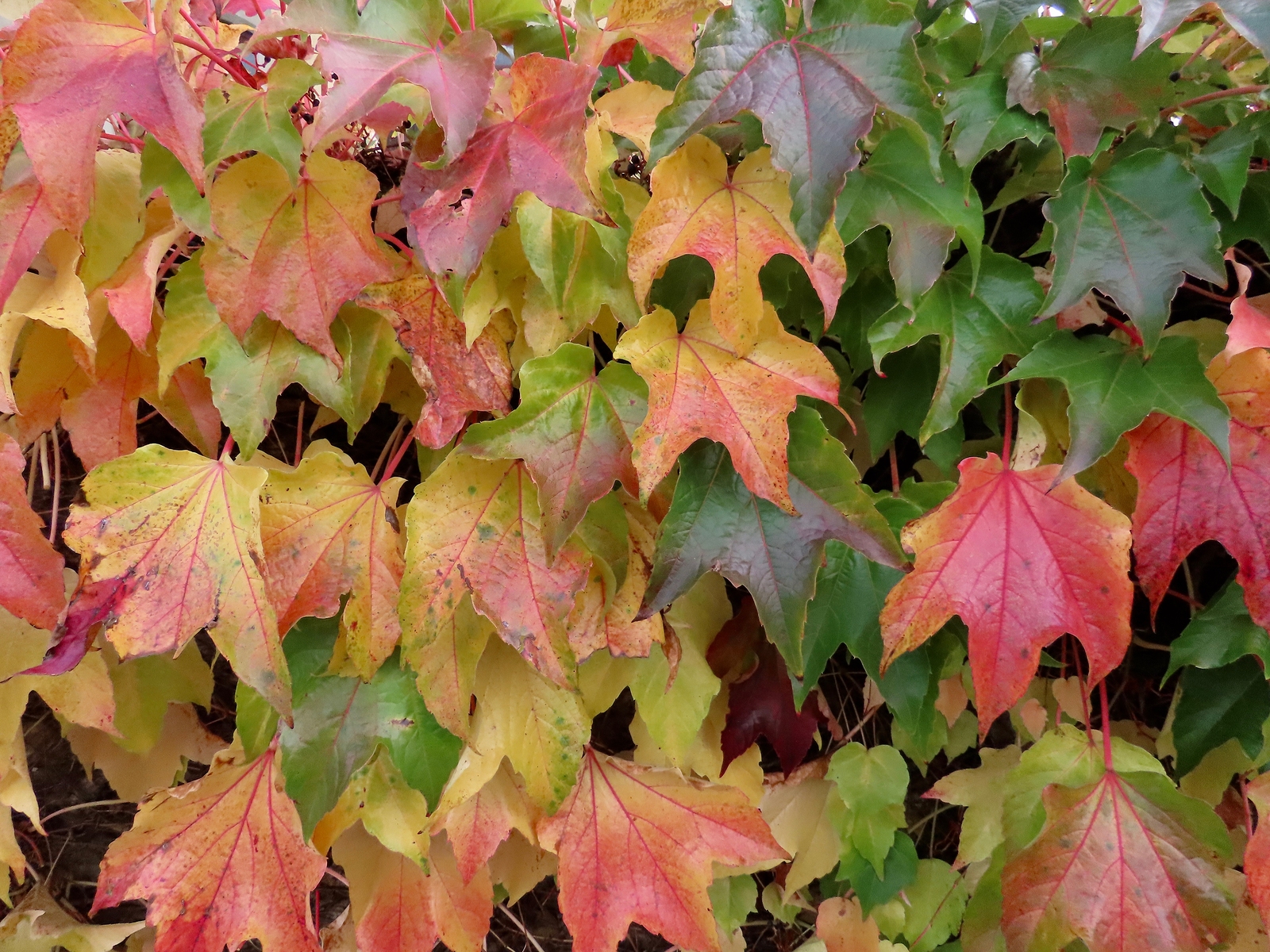 Parthenocissus spp. (Virginia creeper, Boston ivy): Clinging vines with three-part leaves up to 8 inches across offer superb orange to scarlet fall color. Inconspicuous flowers are followed by dark blue to black fruits. Fruits attract mockingbirds, nuthatches, woodpeckers, and blue jays. Grows best in Zones 4-8.
Parthenocissus spp. (Virginia creeper, Boston ivy): Clinging vines with three-part leaves up to 8 inches across offer superb orange to scarlet fall color. Inconspicuous flowers are followed by dark blue to black fruits. Fruits attract mockingbirds, nuthatches, woodpeckers, and blue jays. Grows best in Zones 4-8.
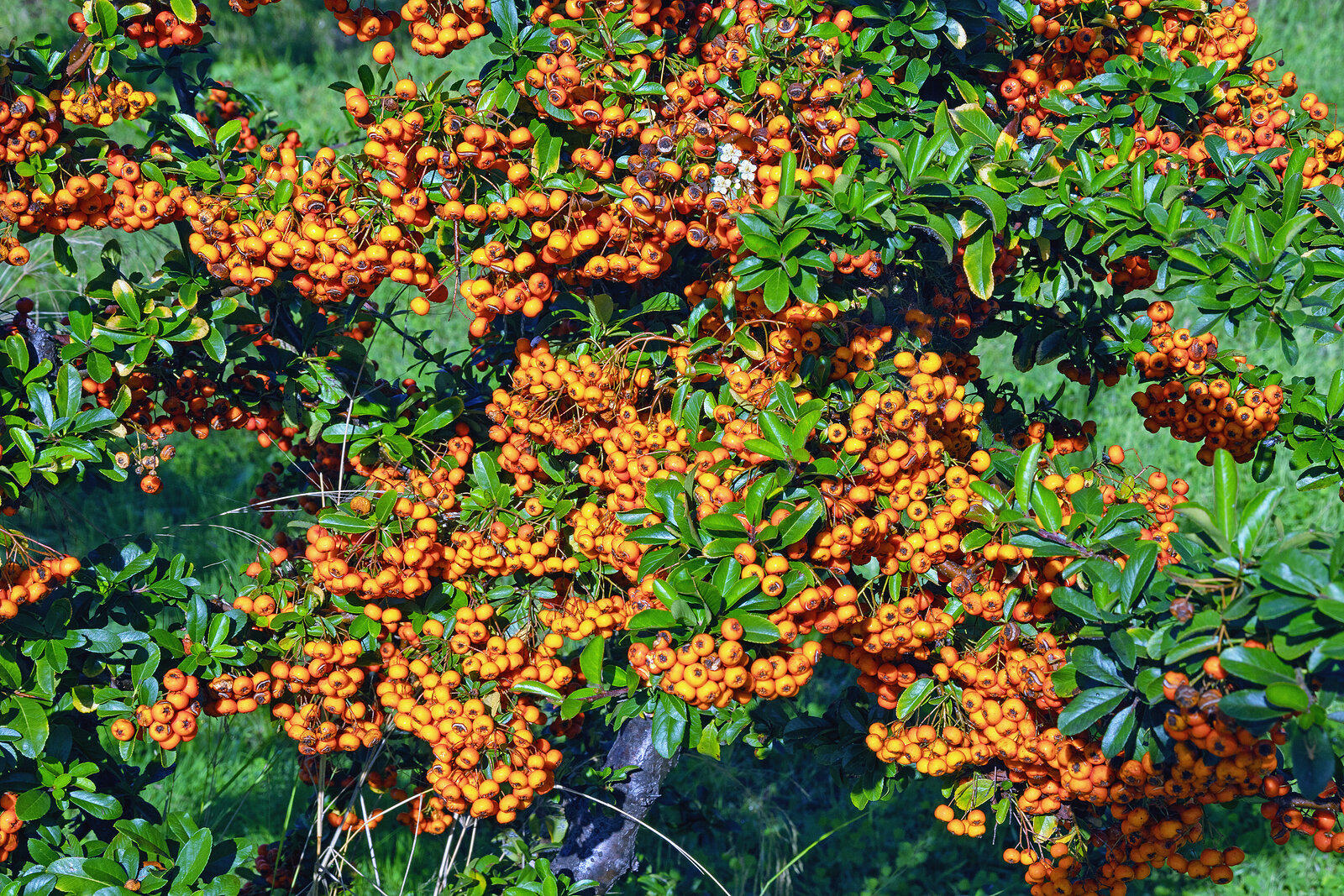 Pyracantha spp. (firethorn): Evergreen shrubs bear small, fragrant, creamy-white flowers in clusters. Thick clusters of pea-size orange-red berries follow and hang on the plant for months. Waxwings, robins, bluebirds, mockingbirds, towhees, purple finches, band-tailed pigeons, and California quail attracted to the berries. Grows best in Zones 6-9.
Pyracantha spp. (firethorn): Evergreen shrubs bear small, fragrant, creamy-white flowers in clusters. Thick clusters of pea-size orange-red berries follow and hang on the plant for months. Waxwings, robins, bluebirds, mockingbirds, towhees, purple finches, band-tailed pigeons, and California quail attracted to the berries. Grows best in Zones 6-9.
Also of interest:


